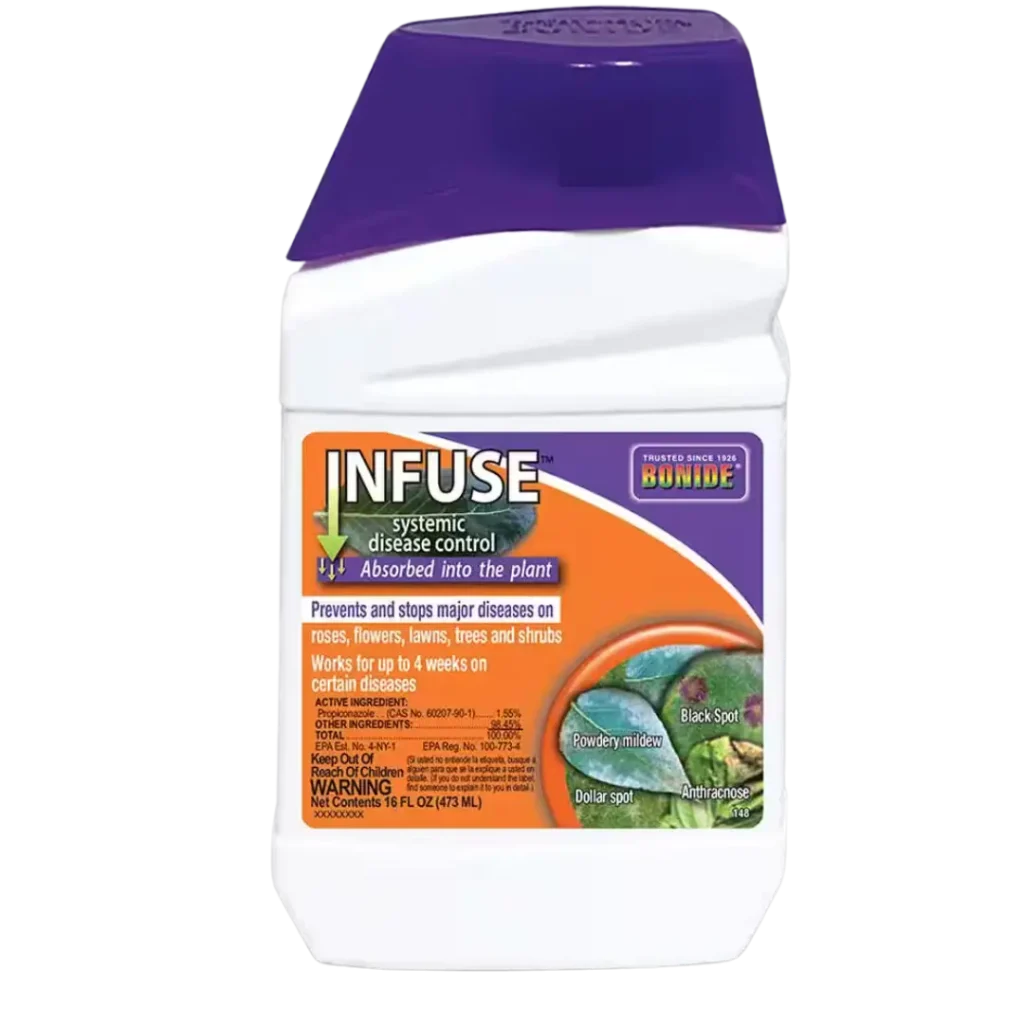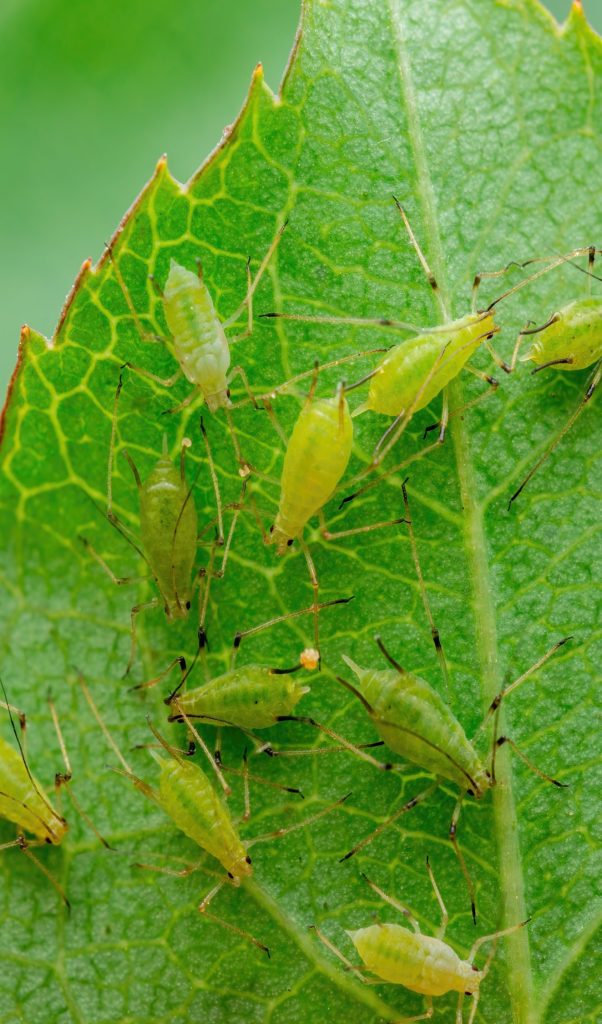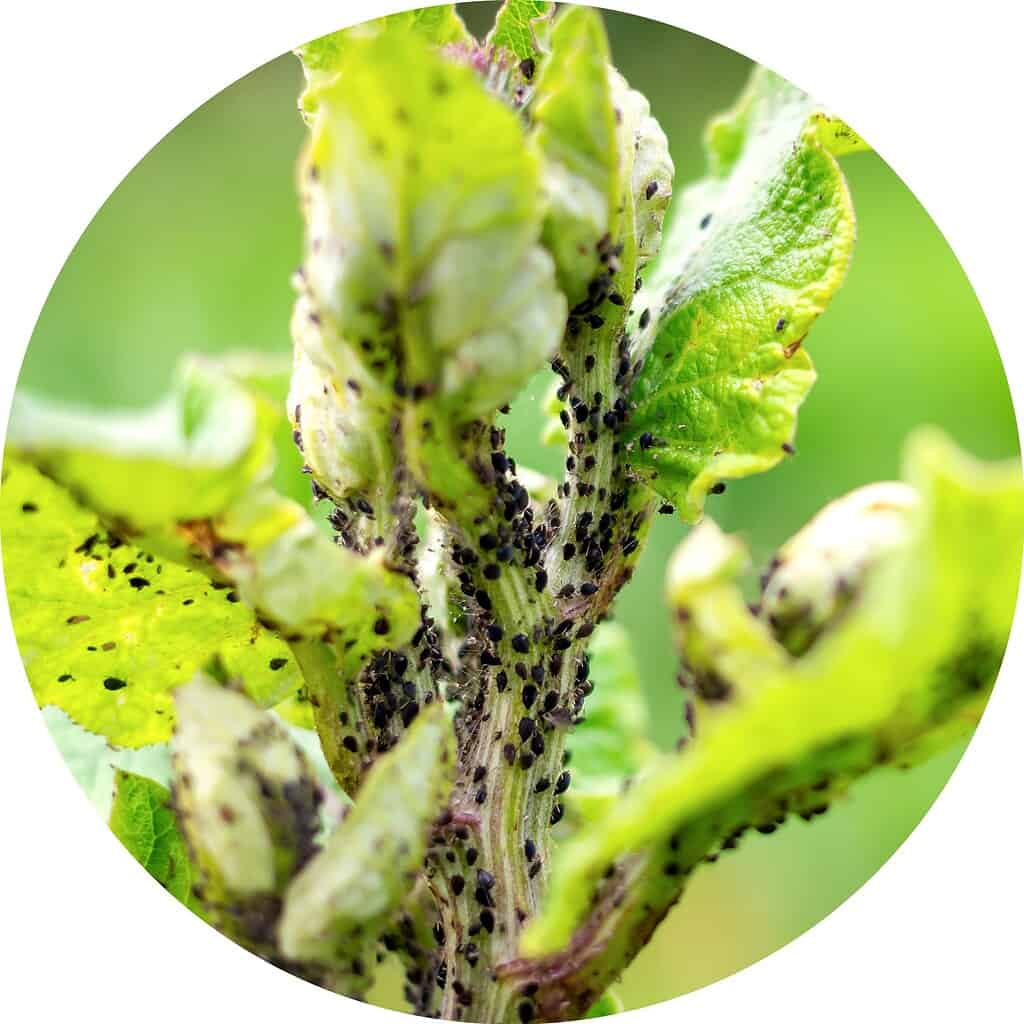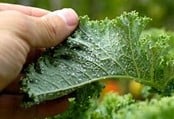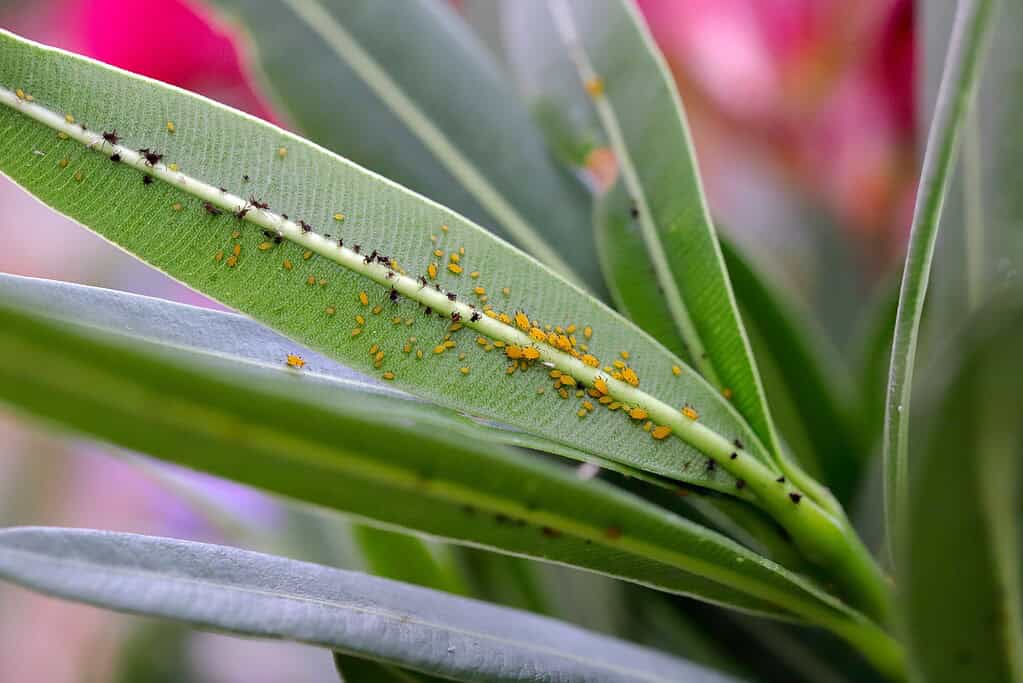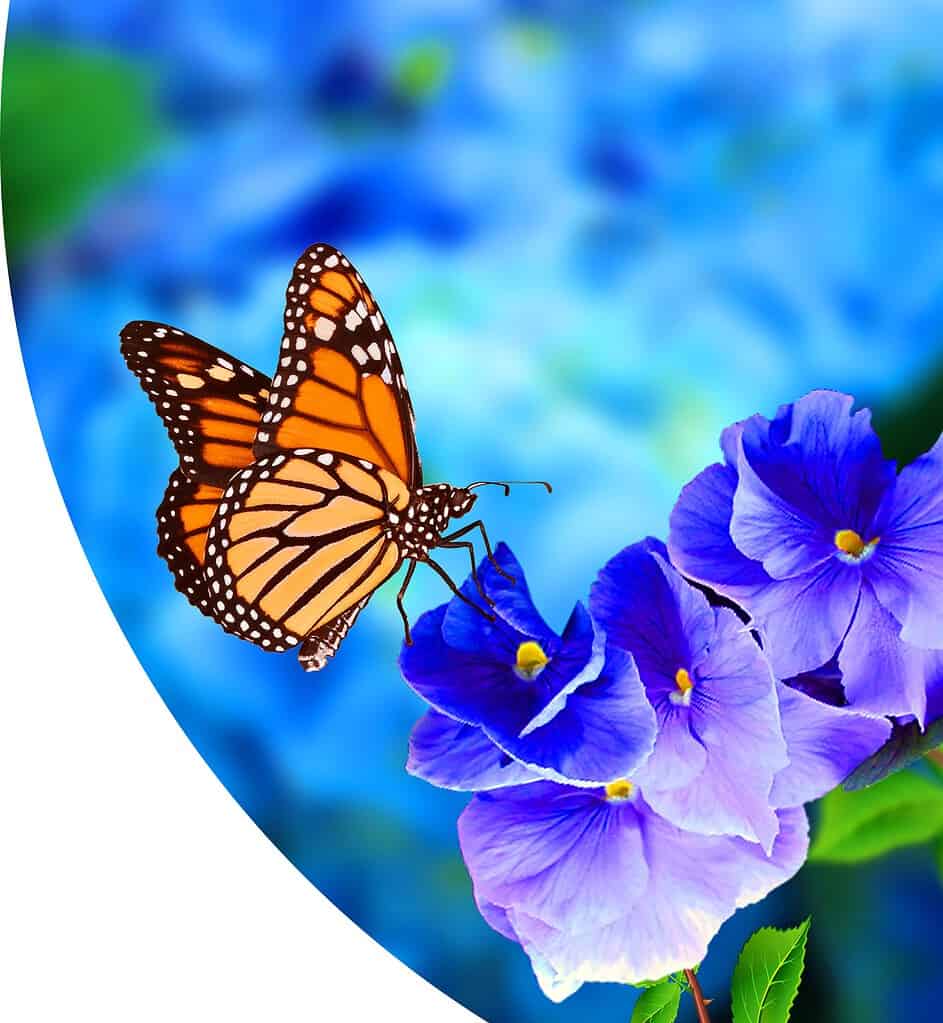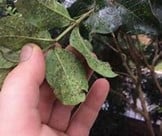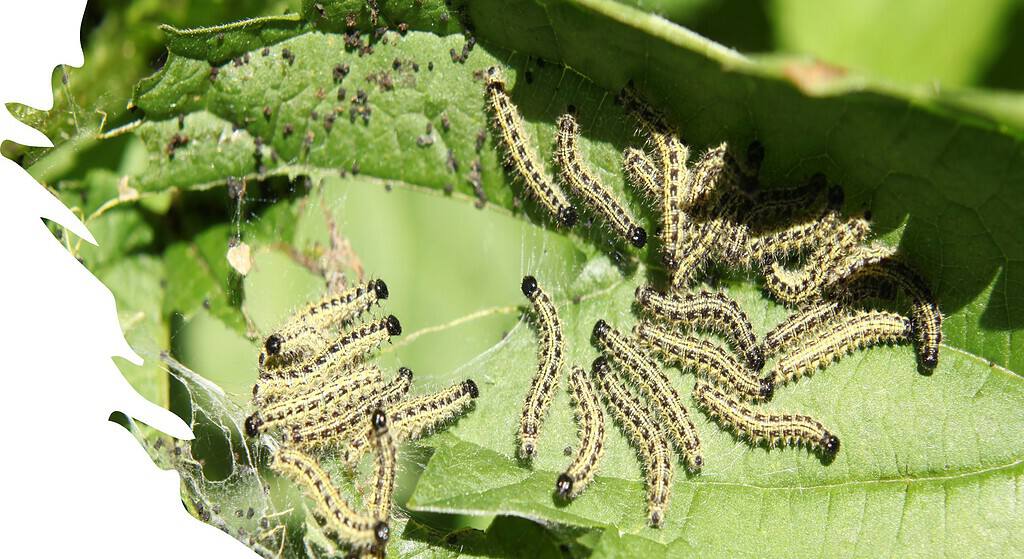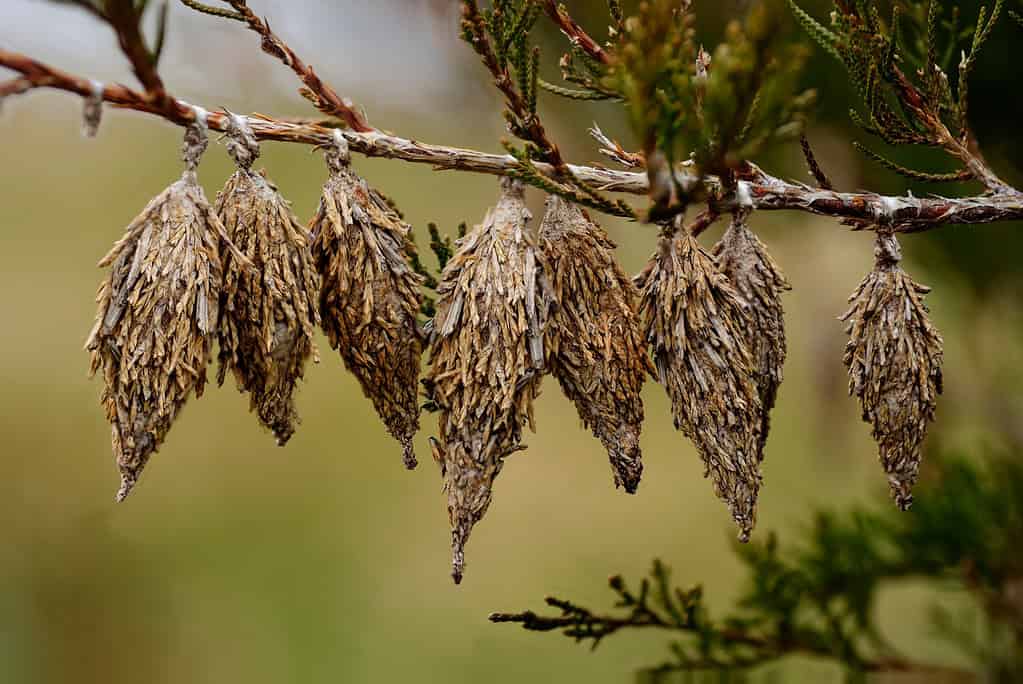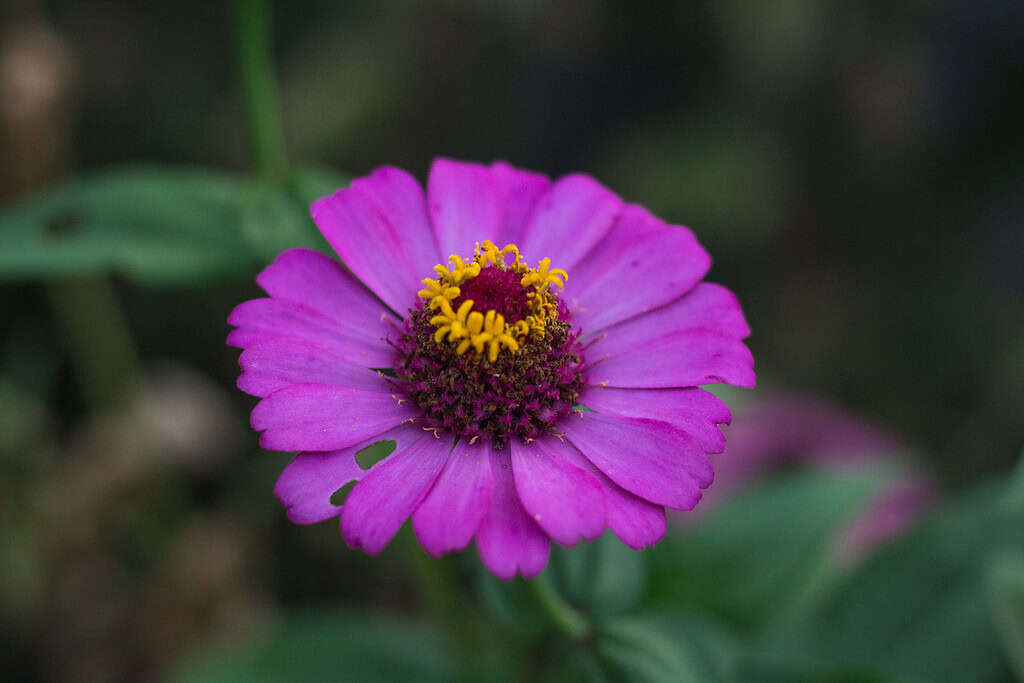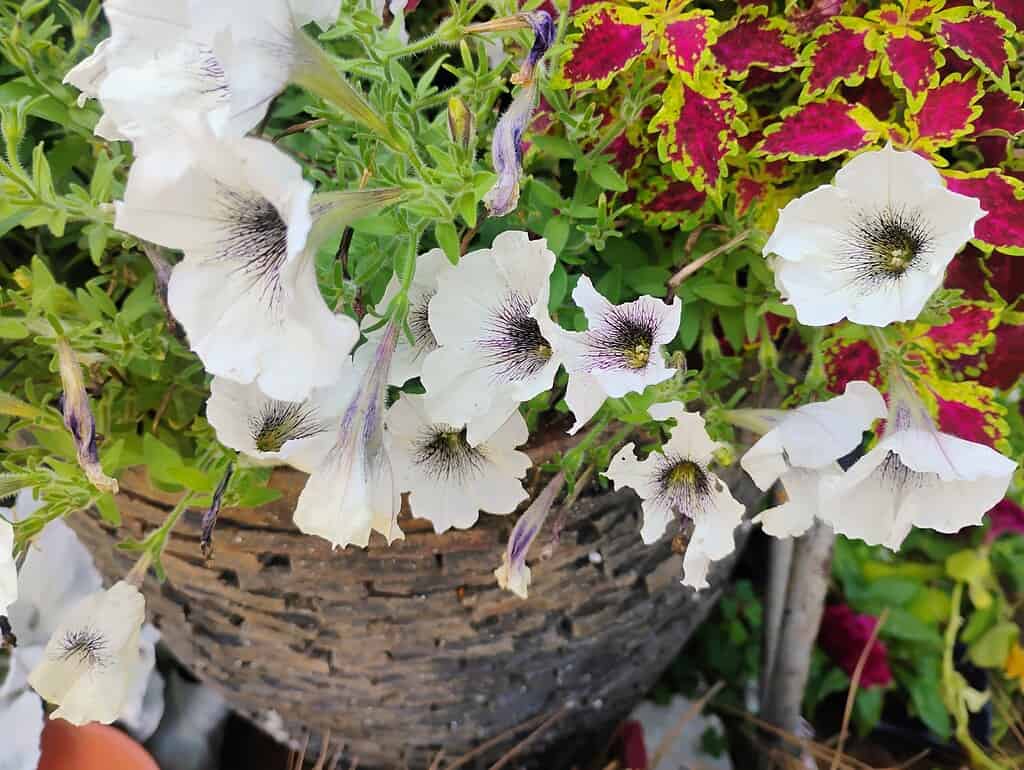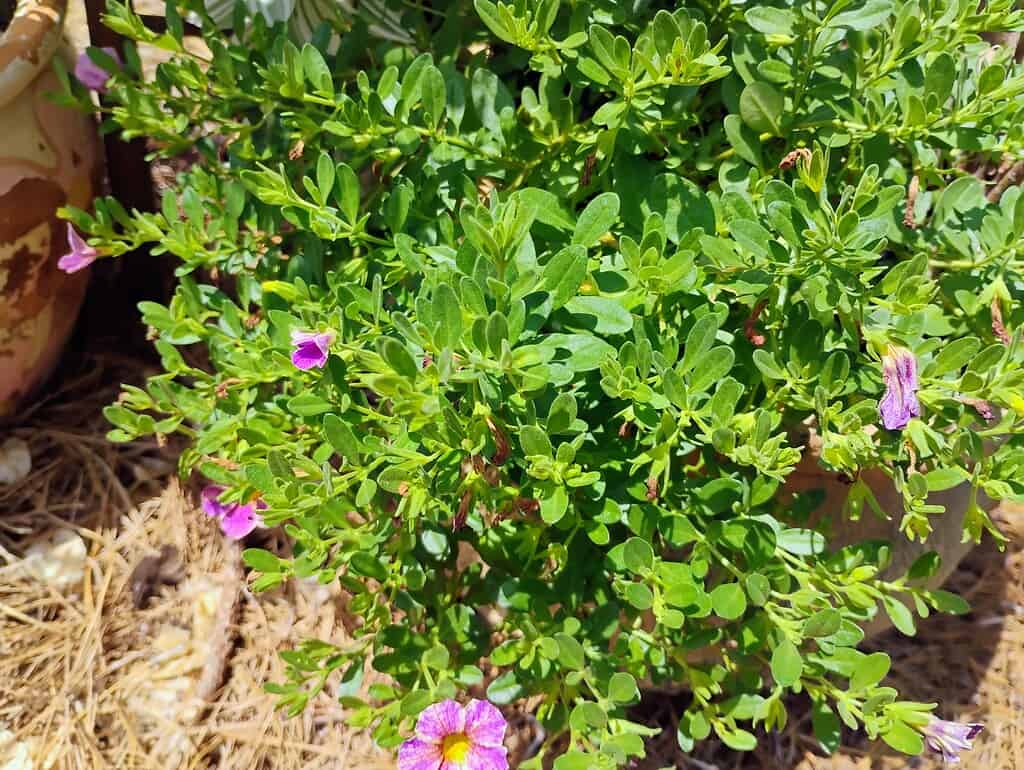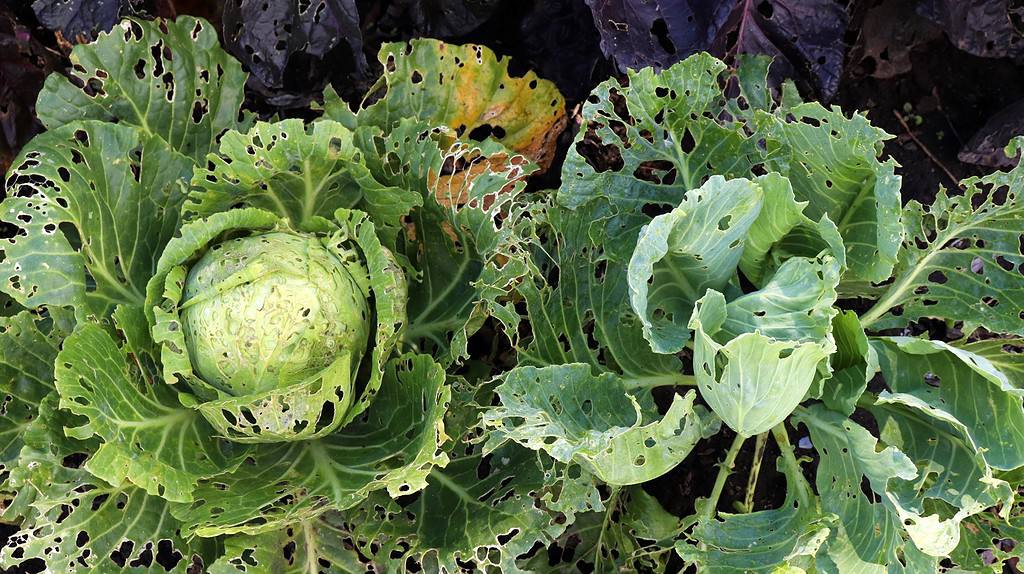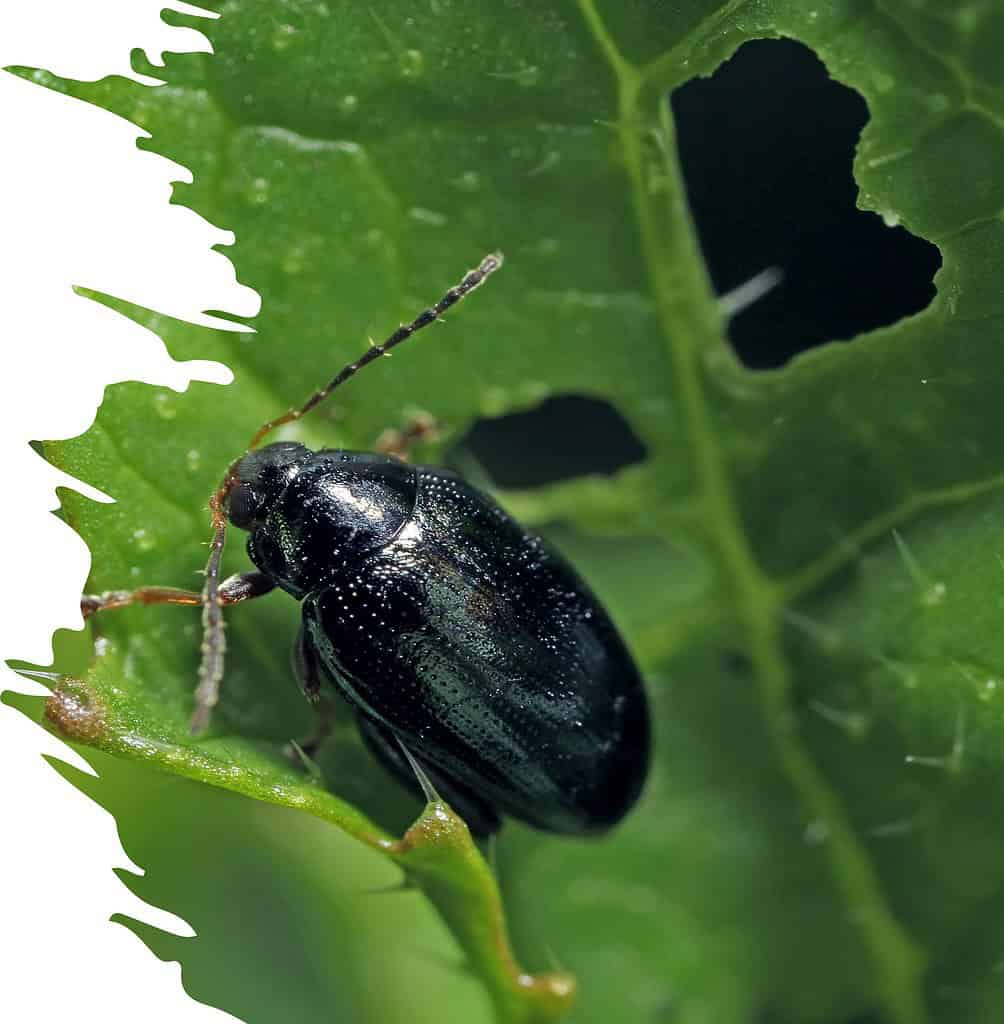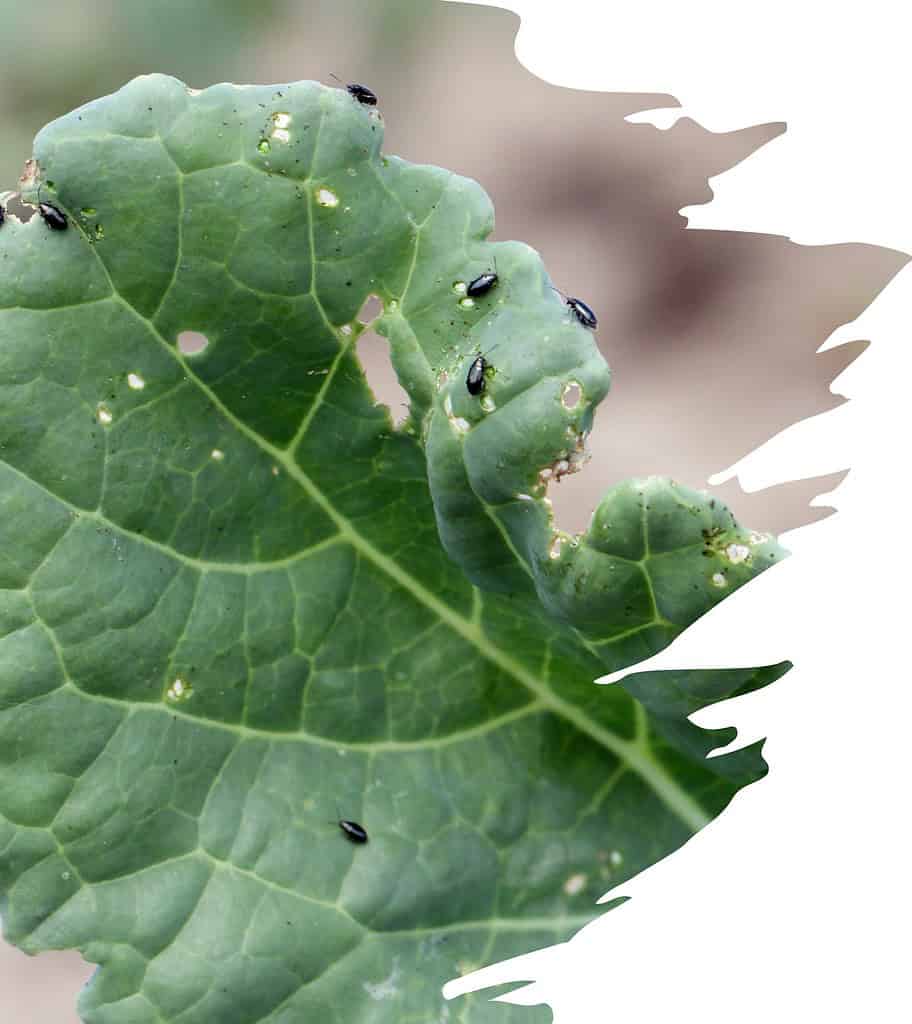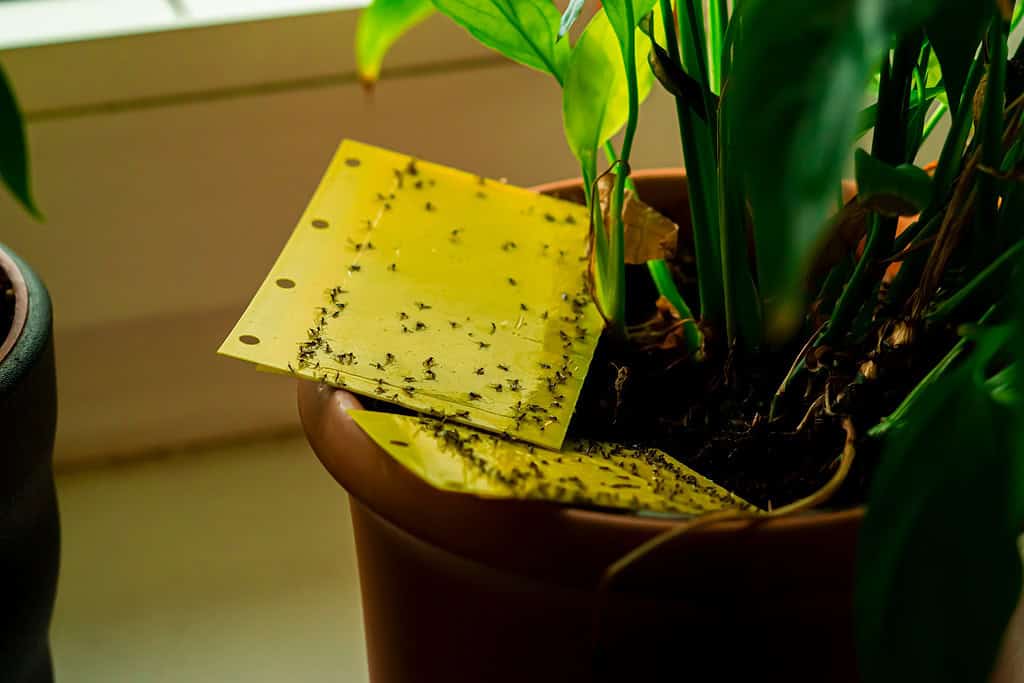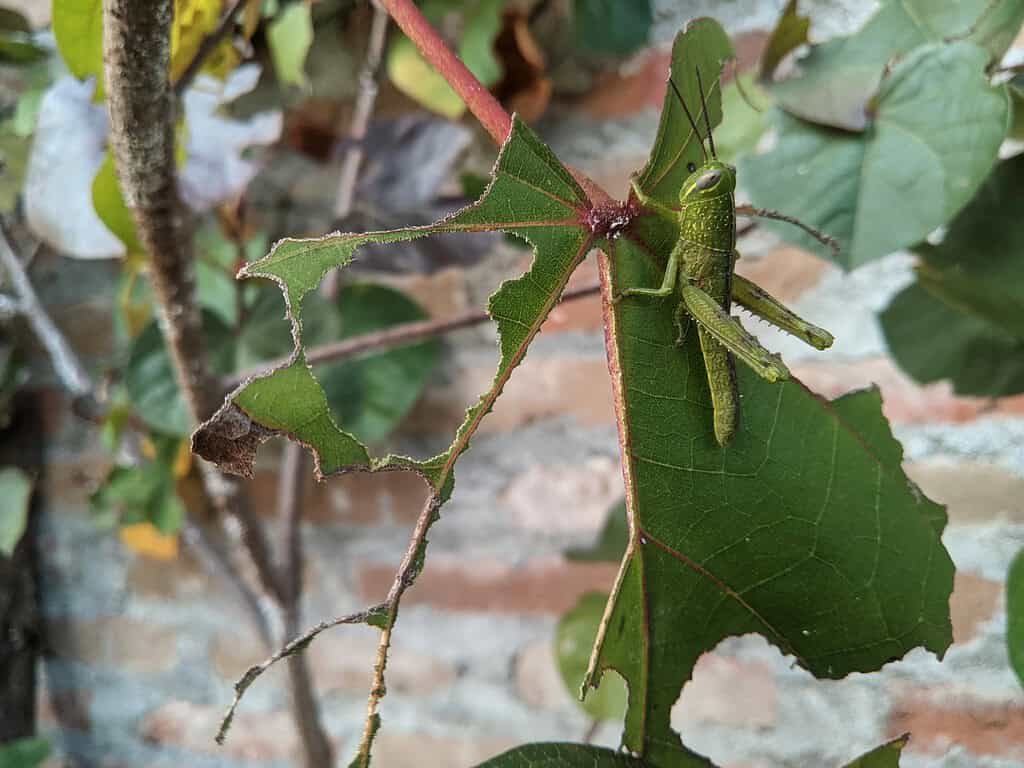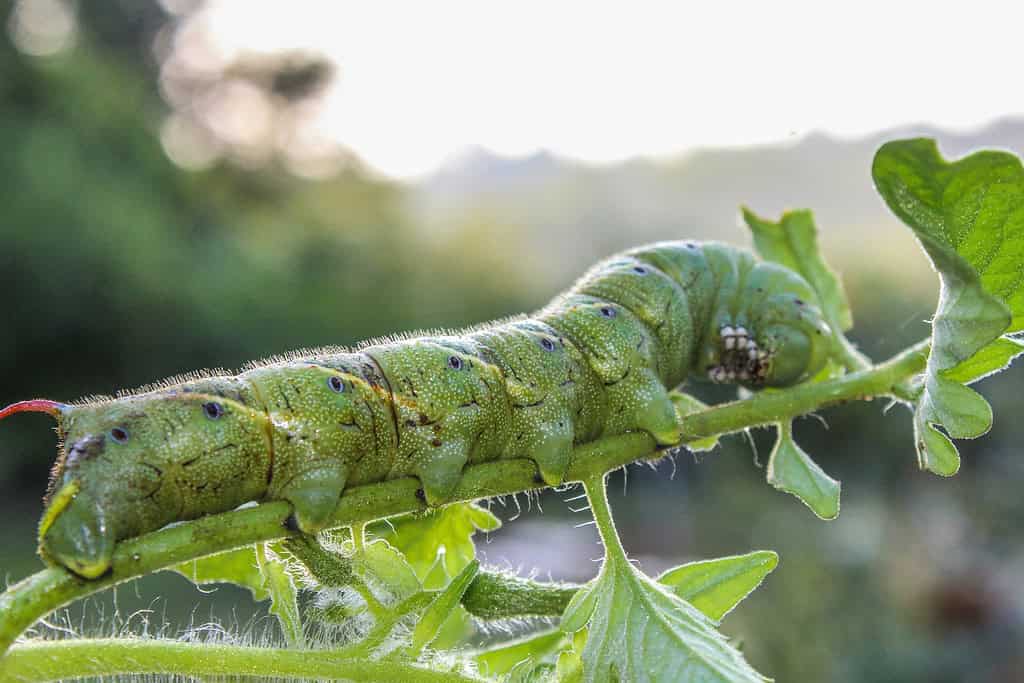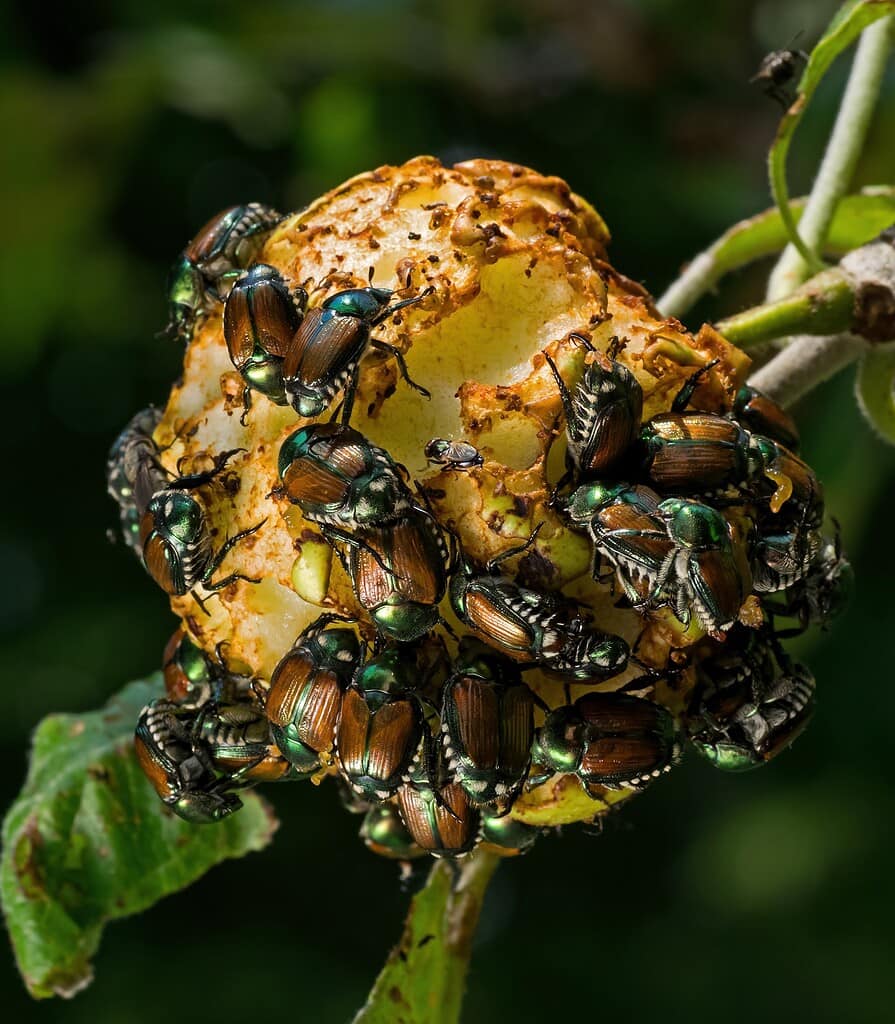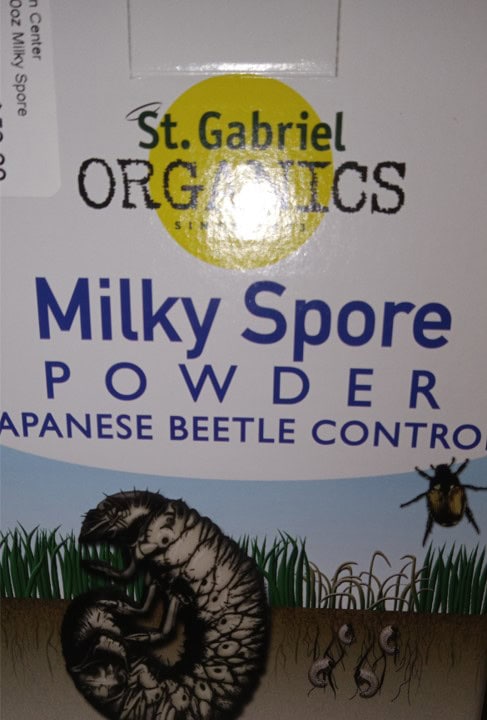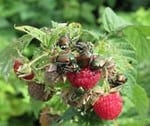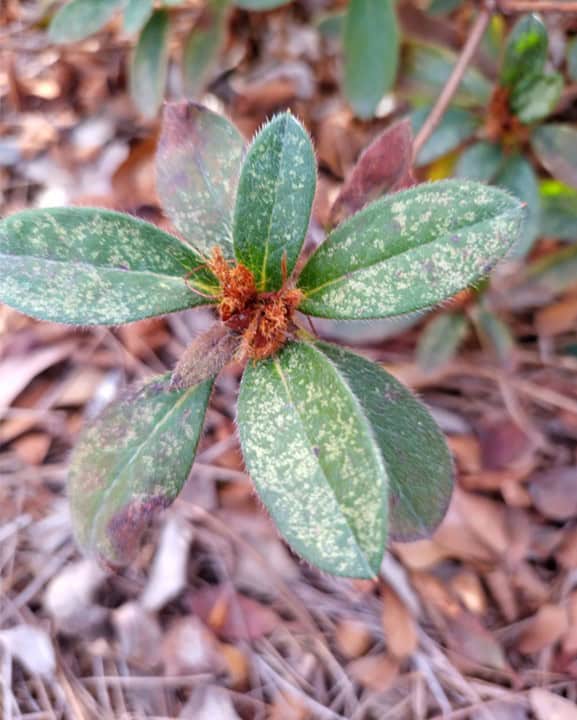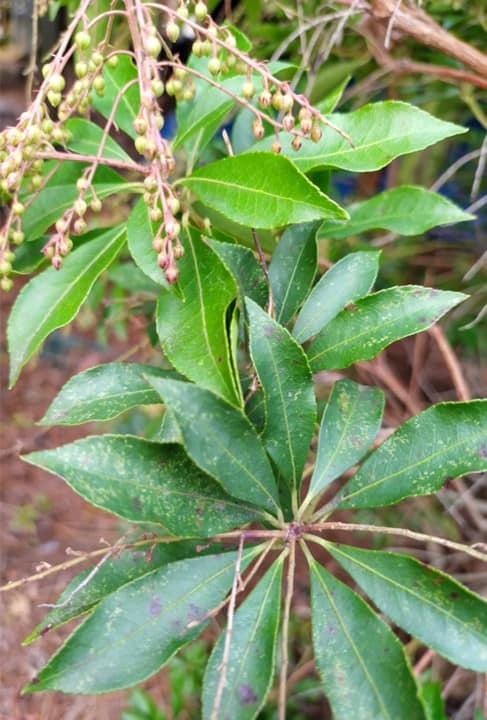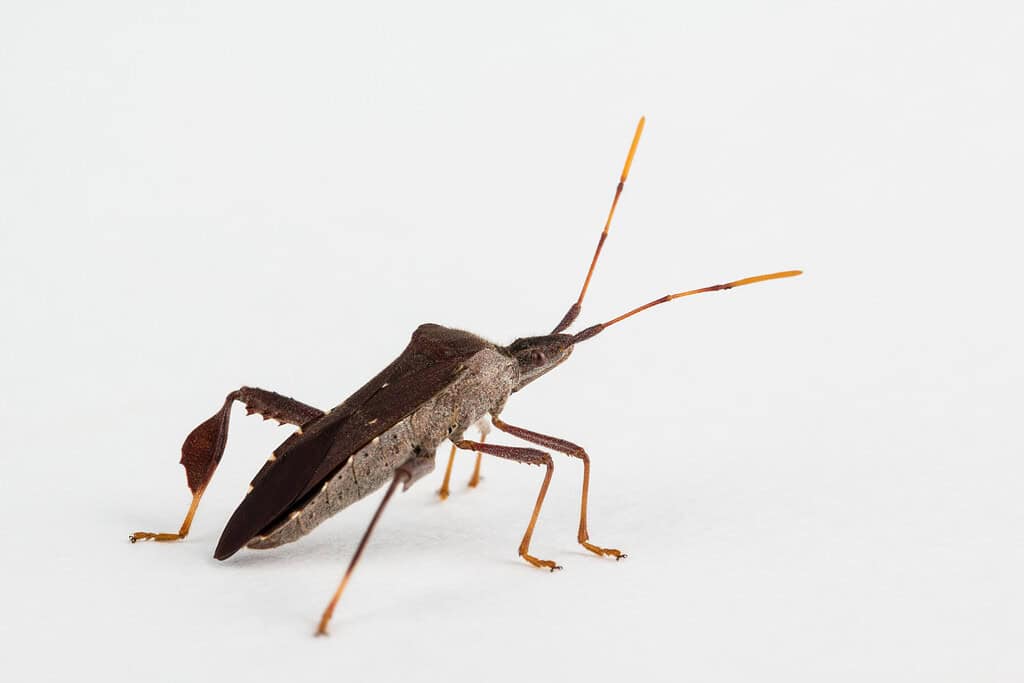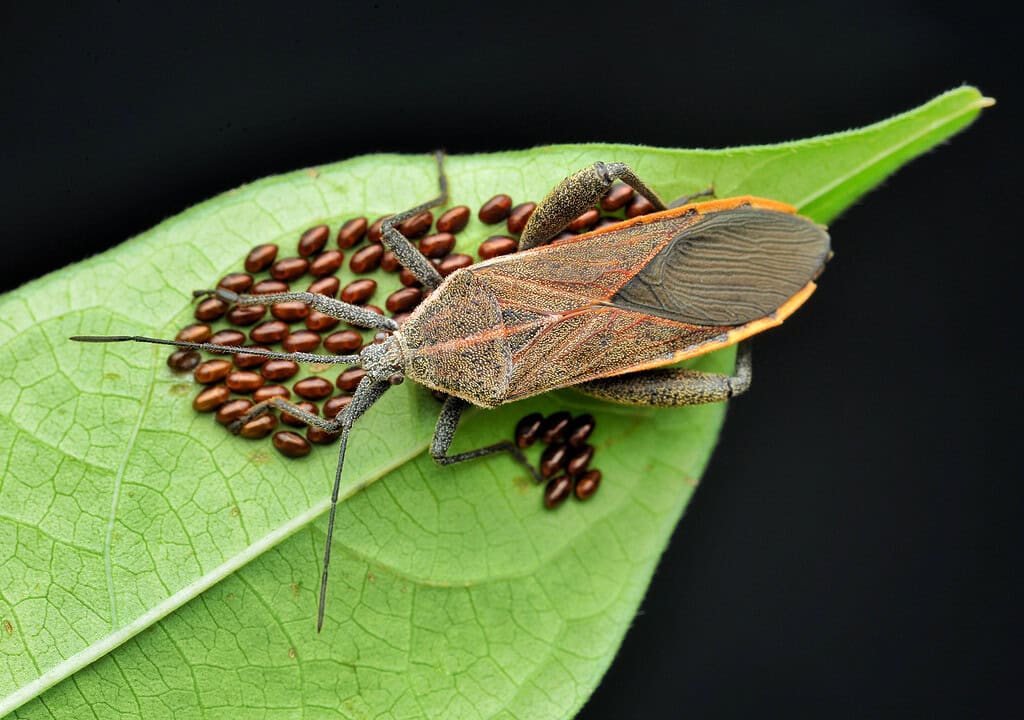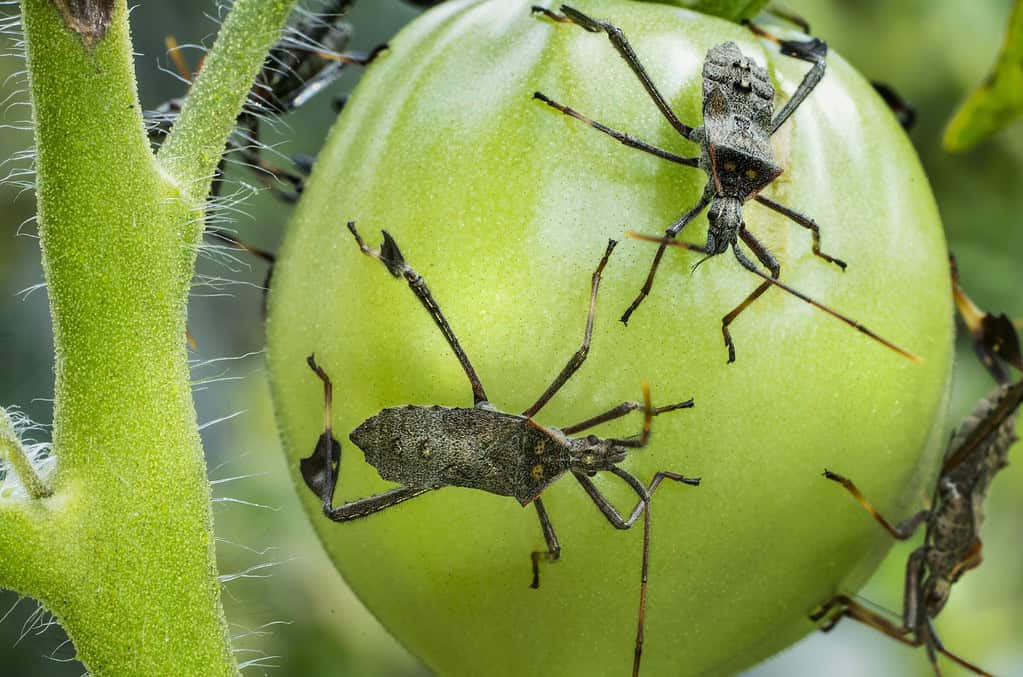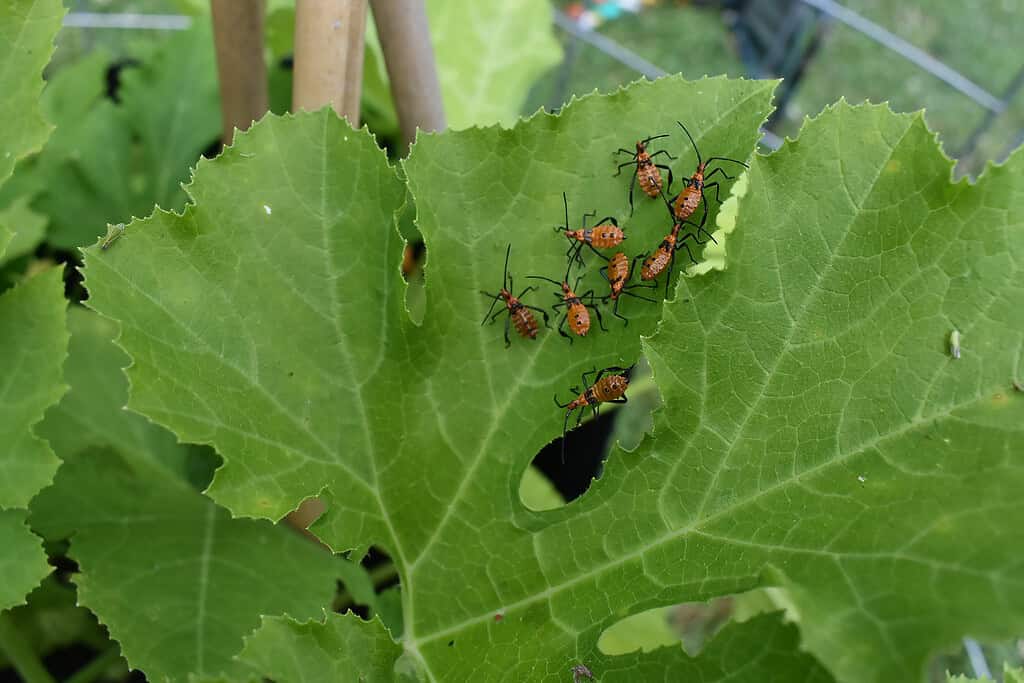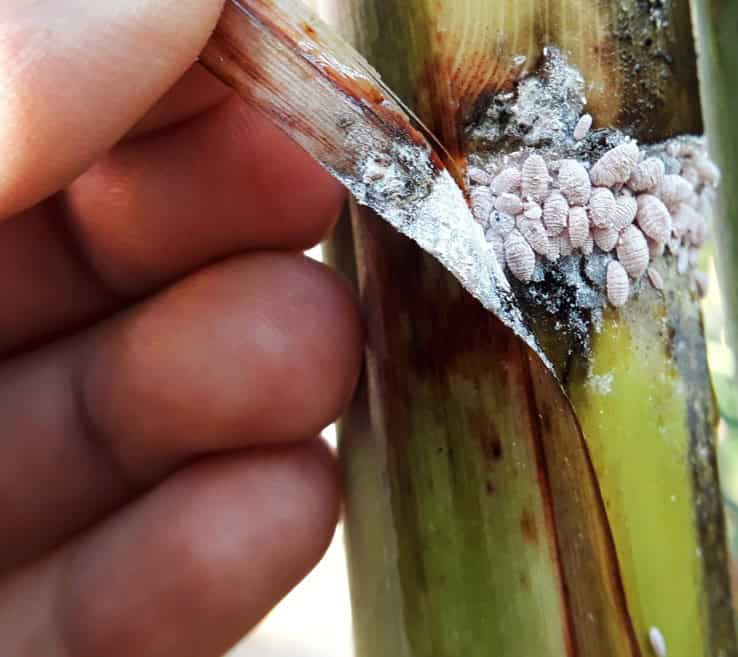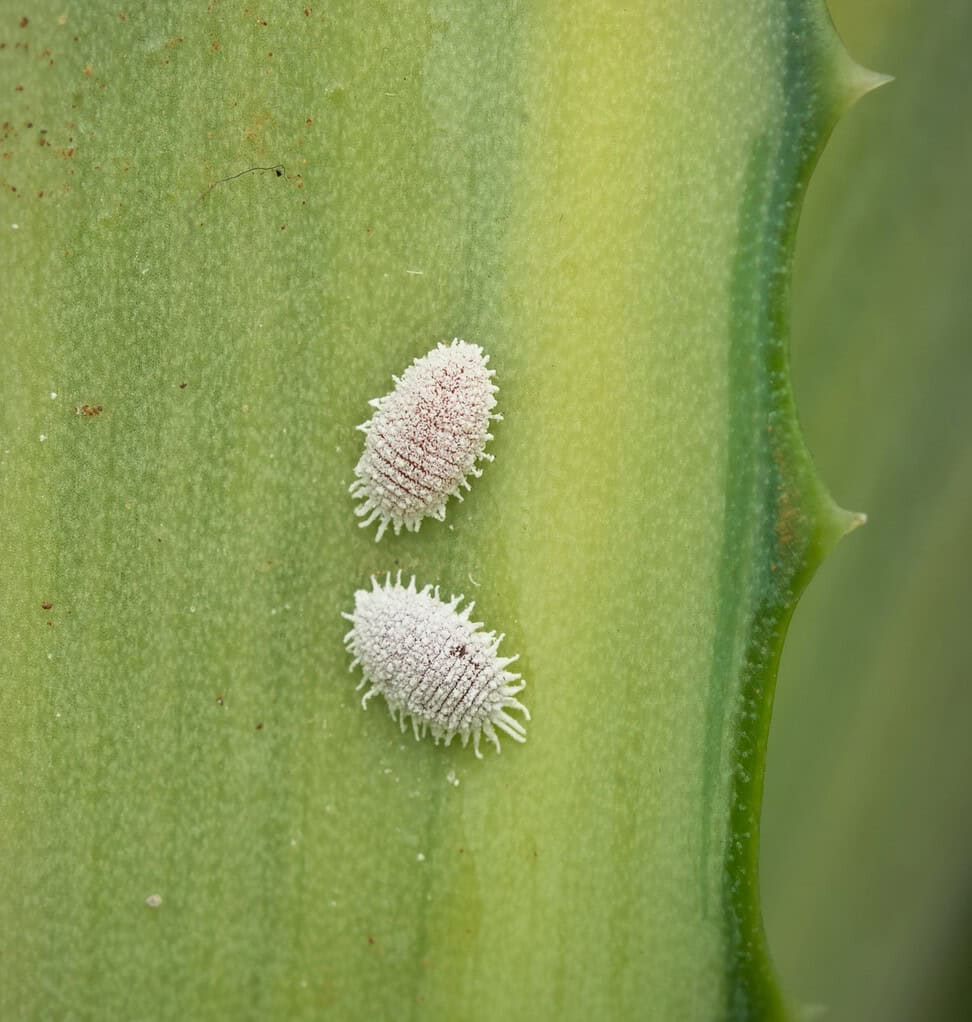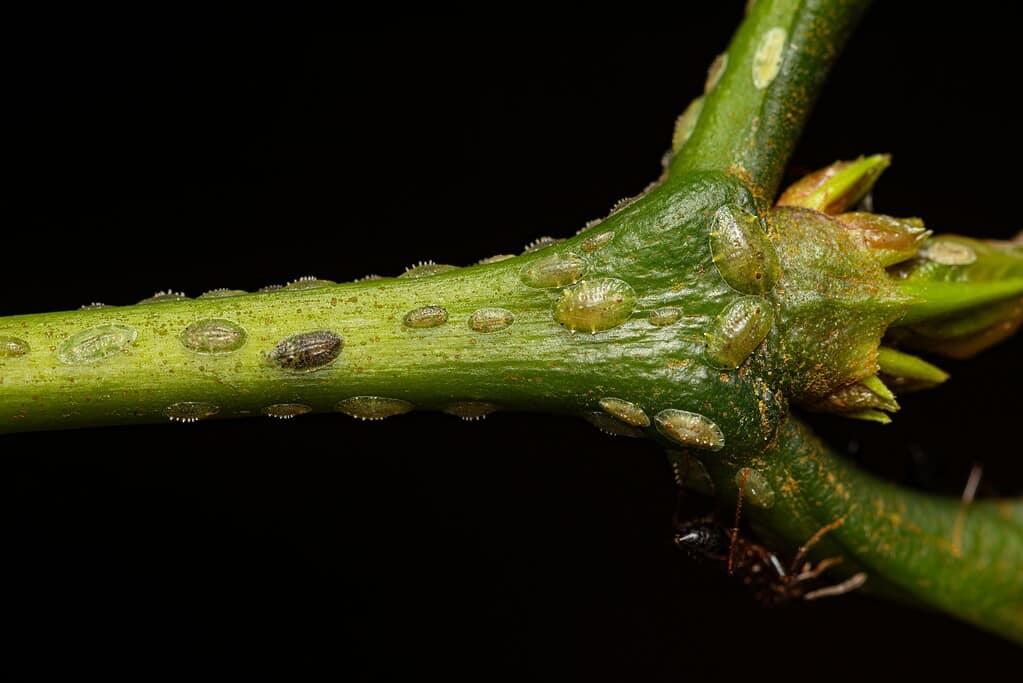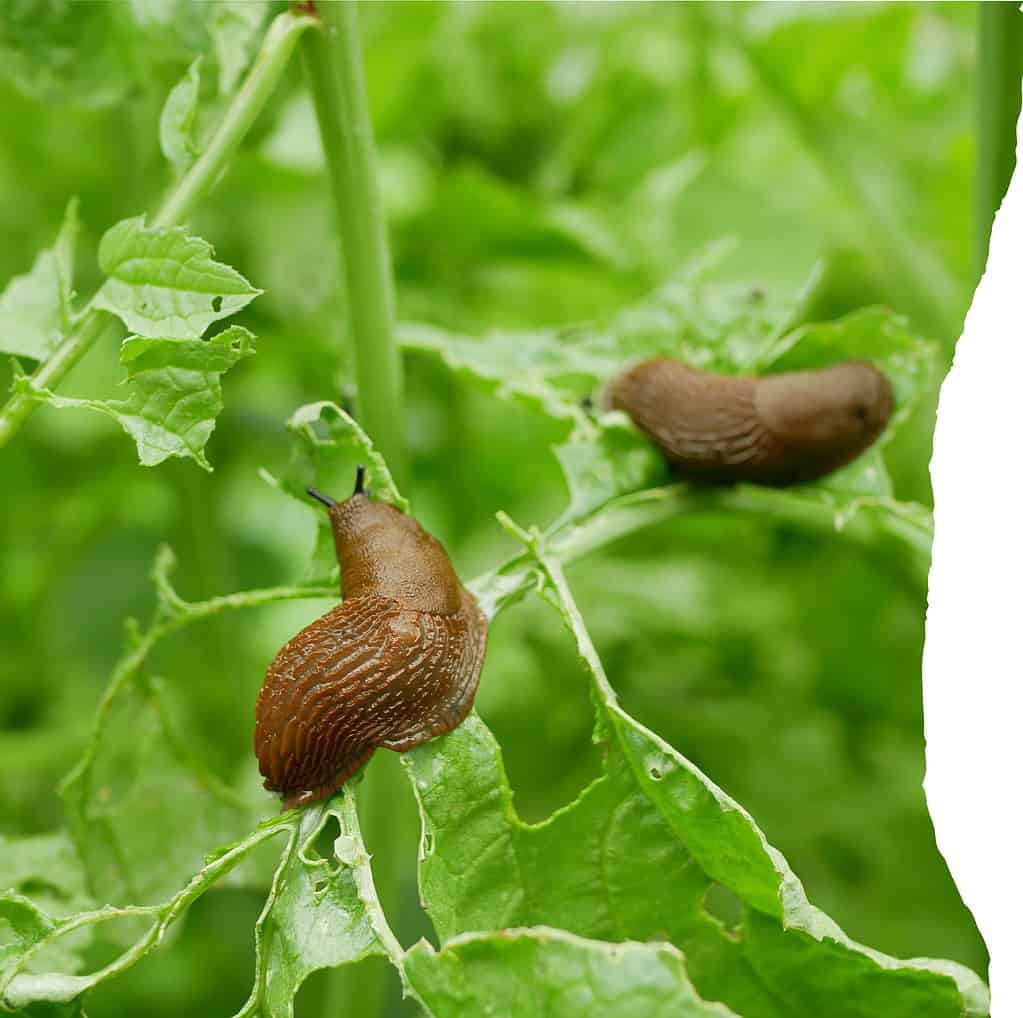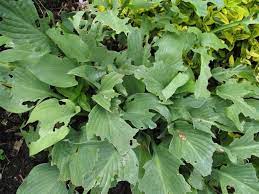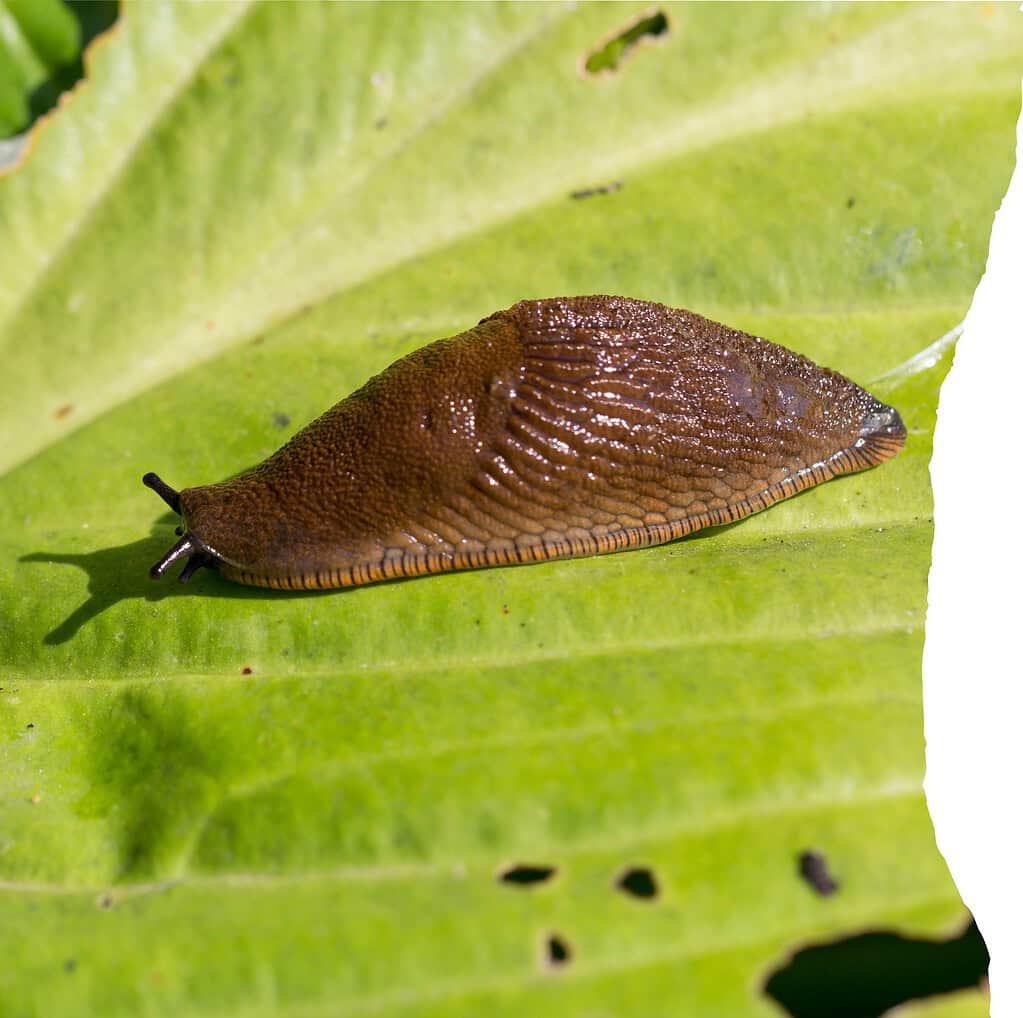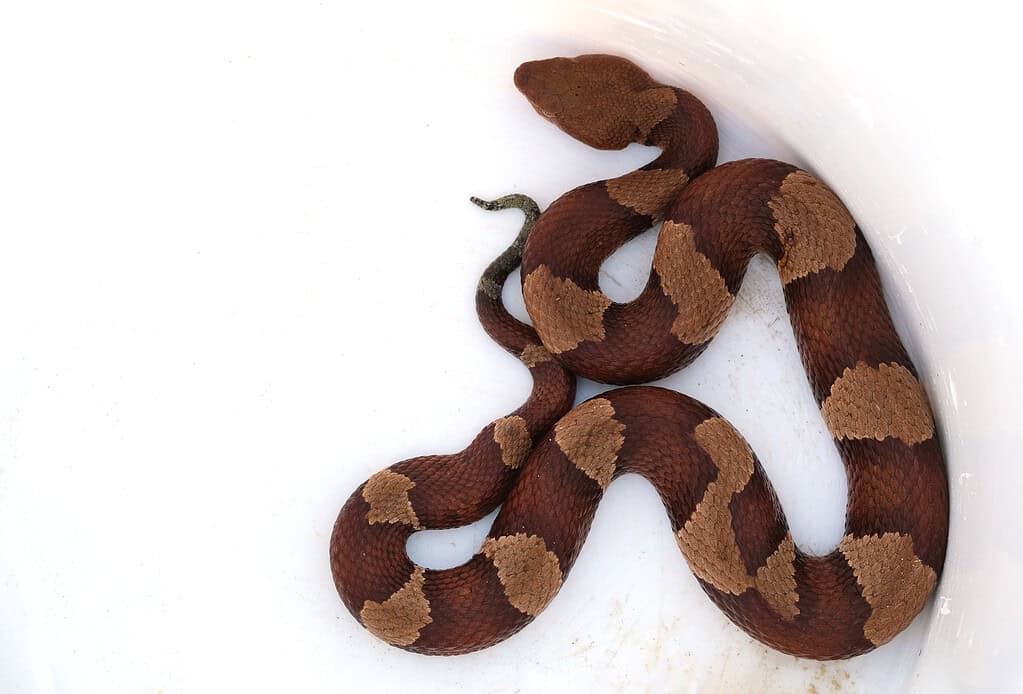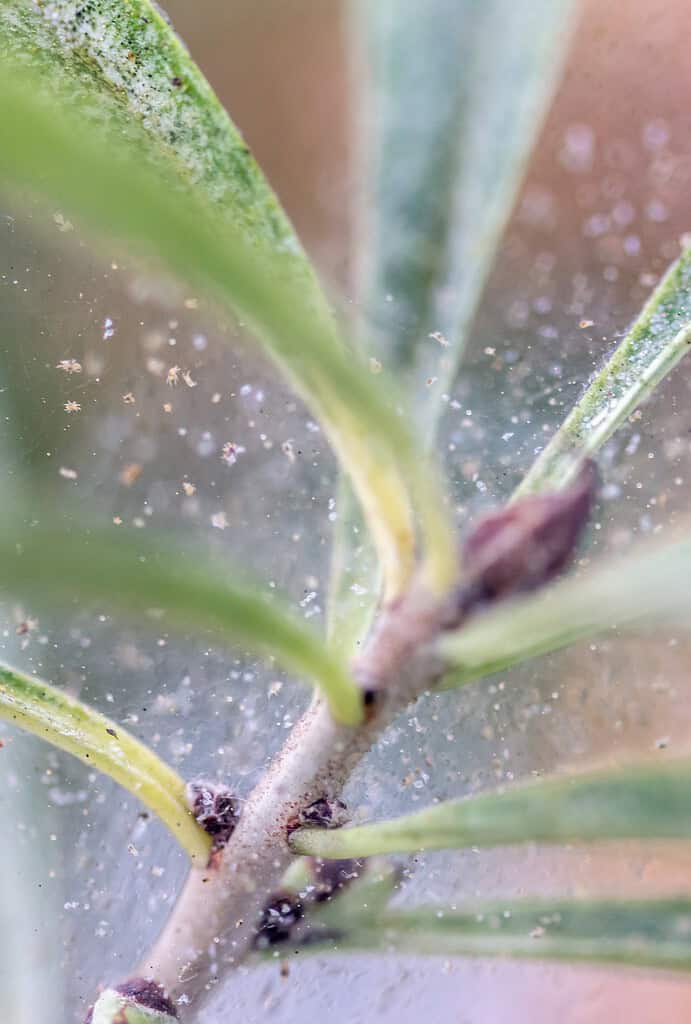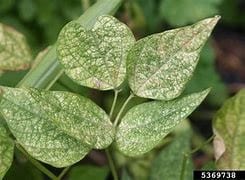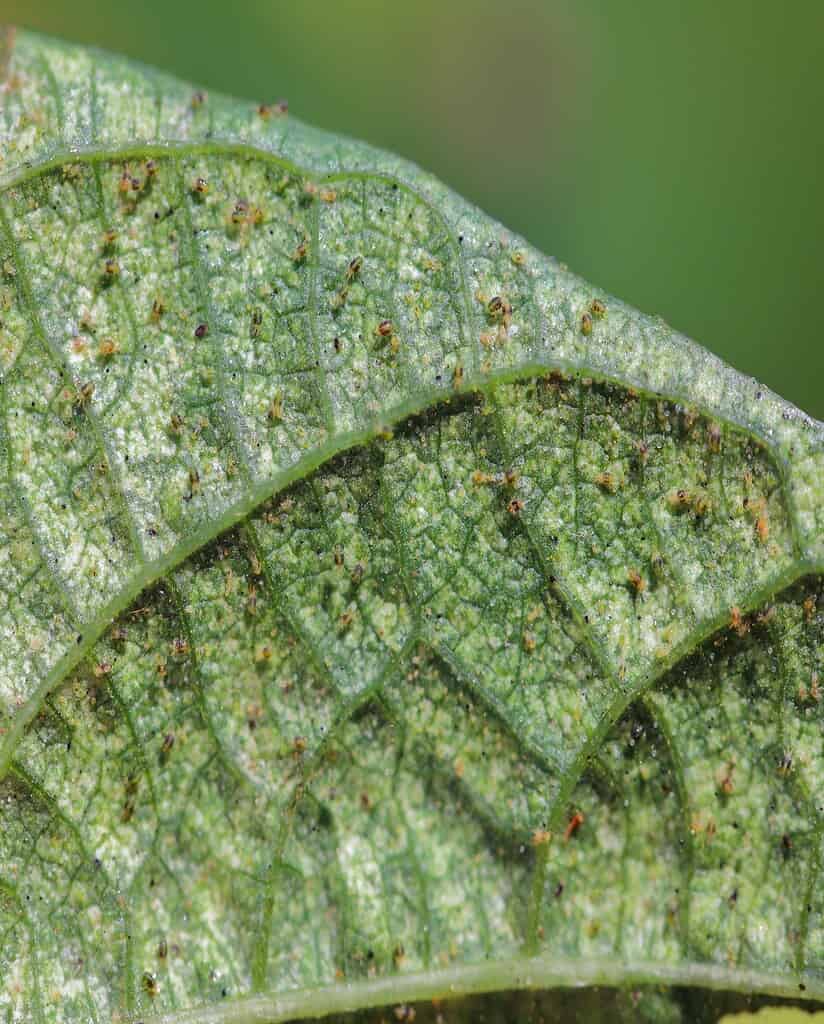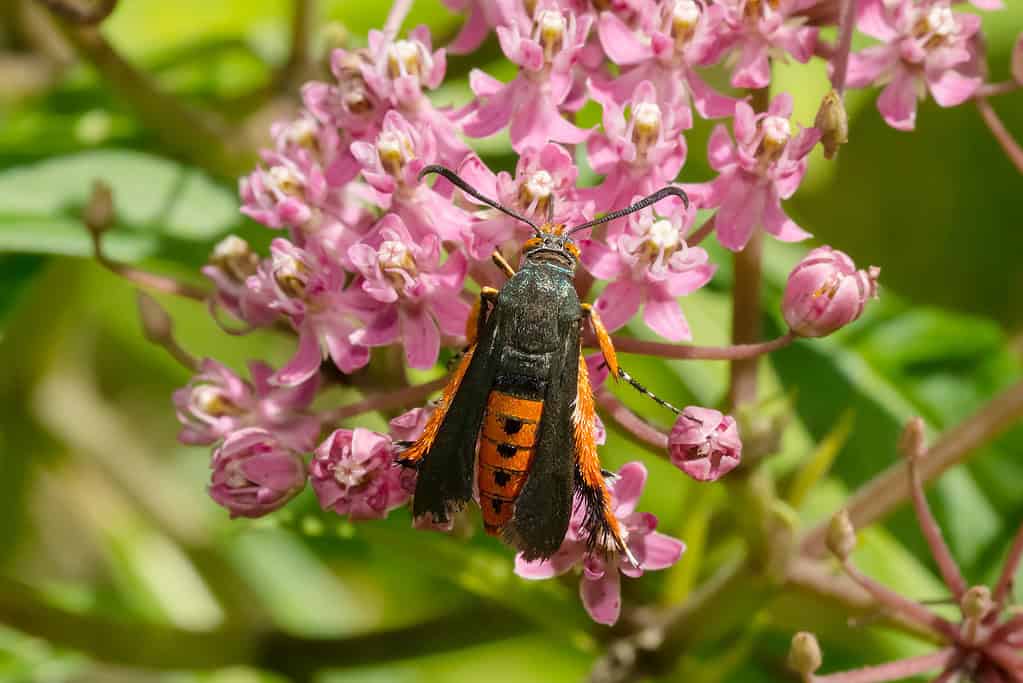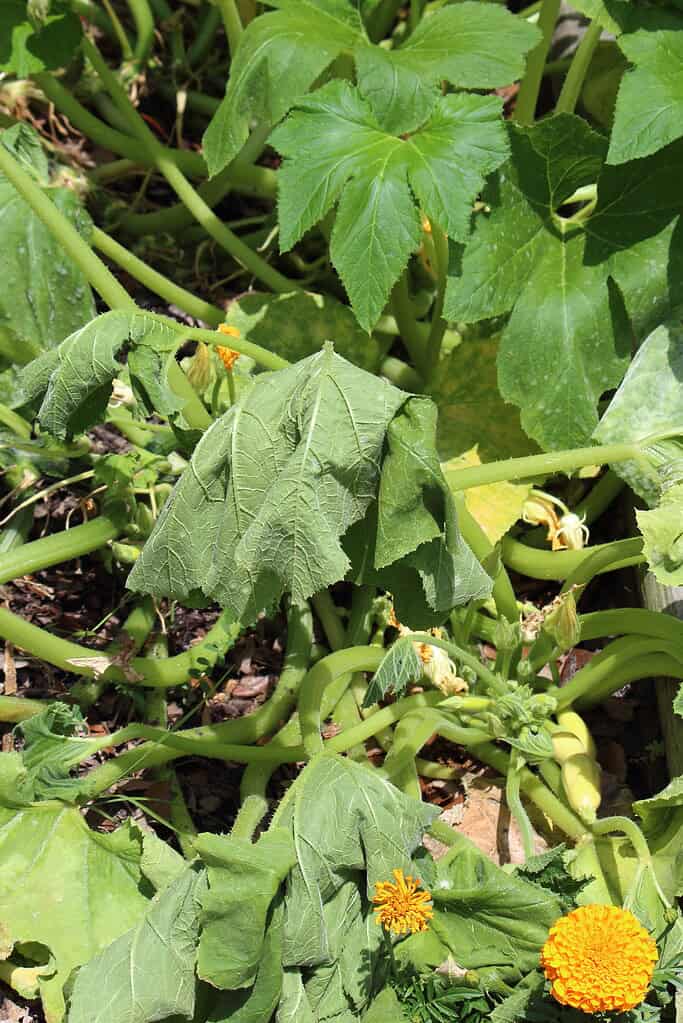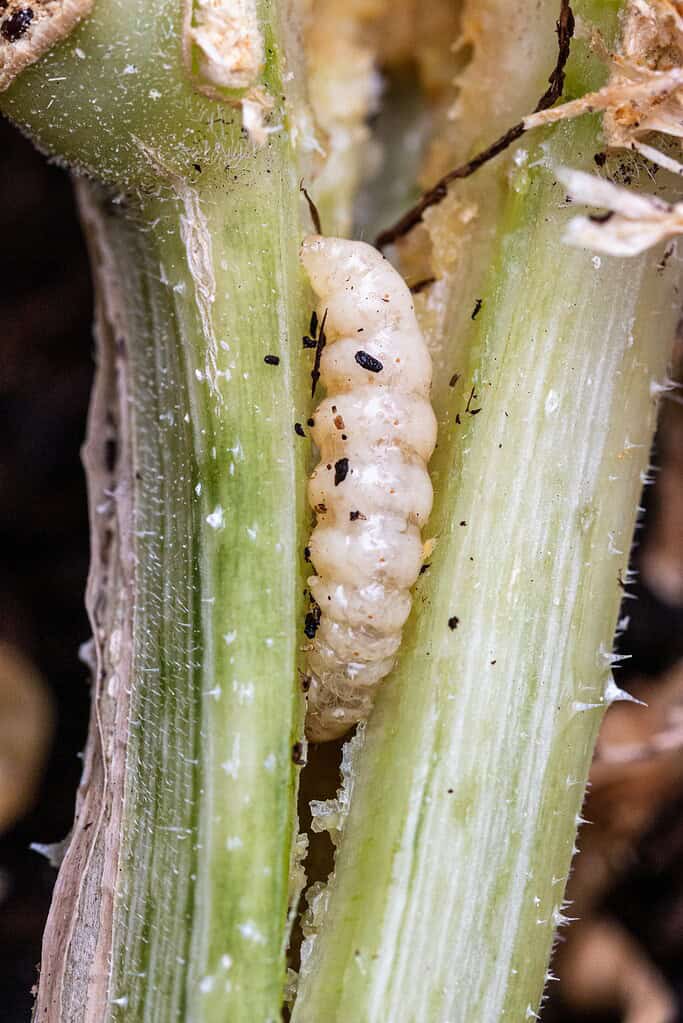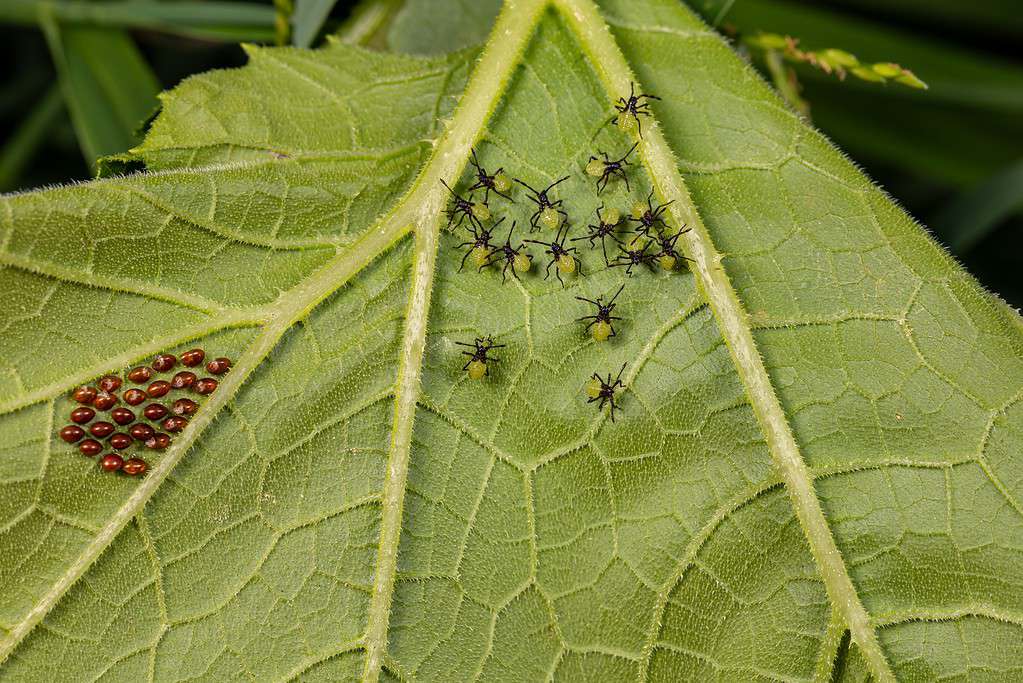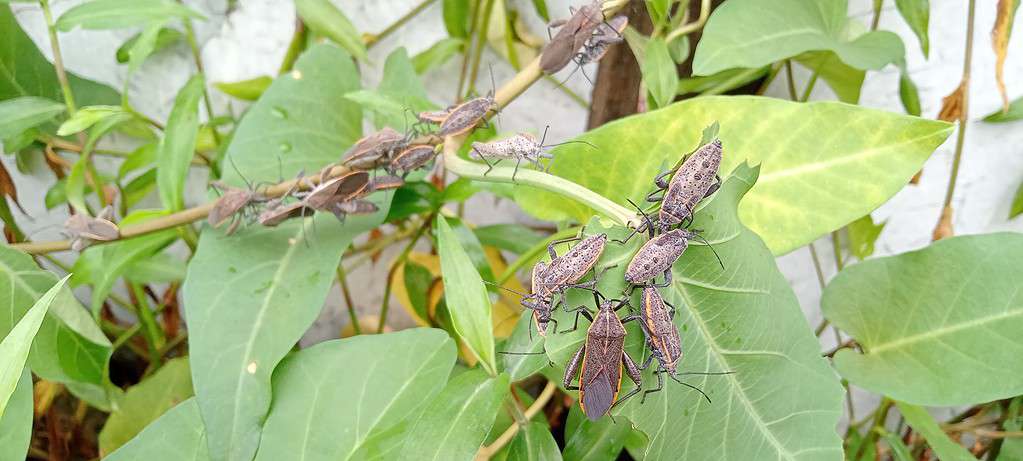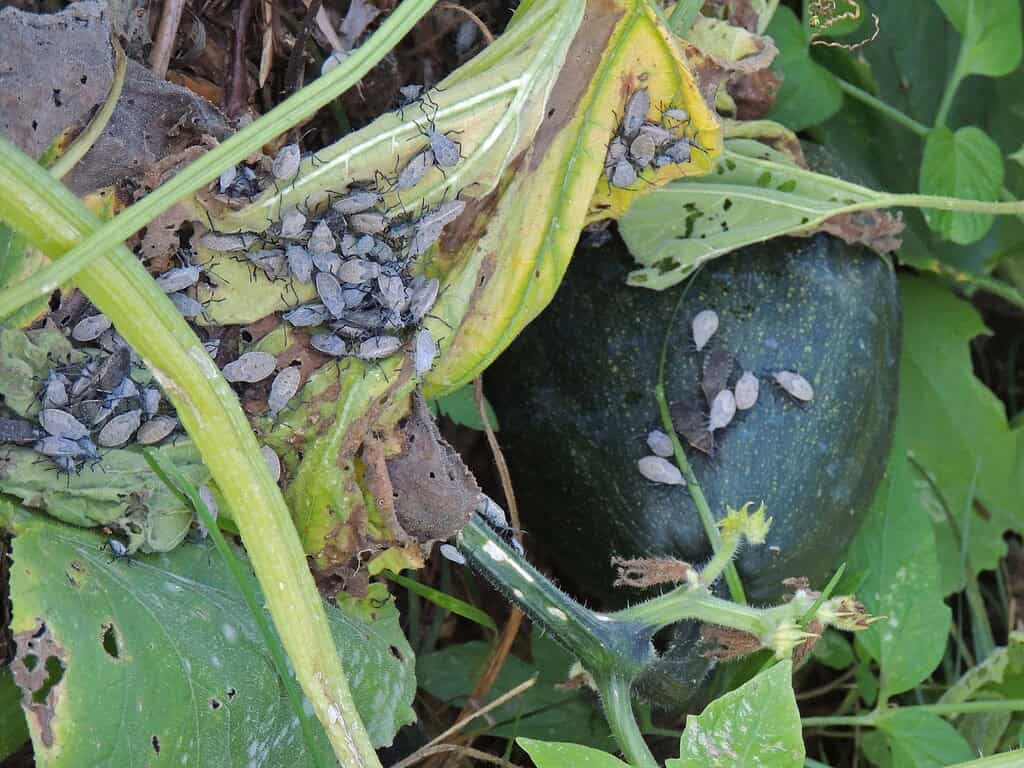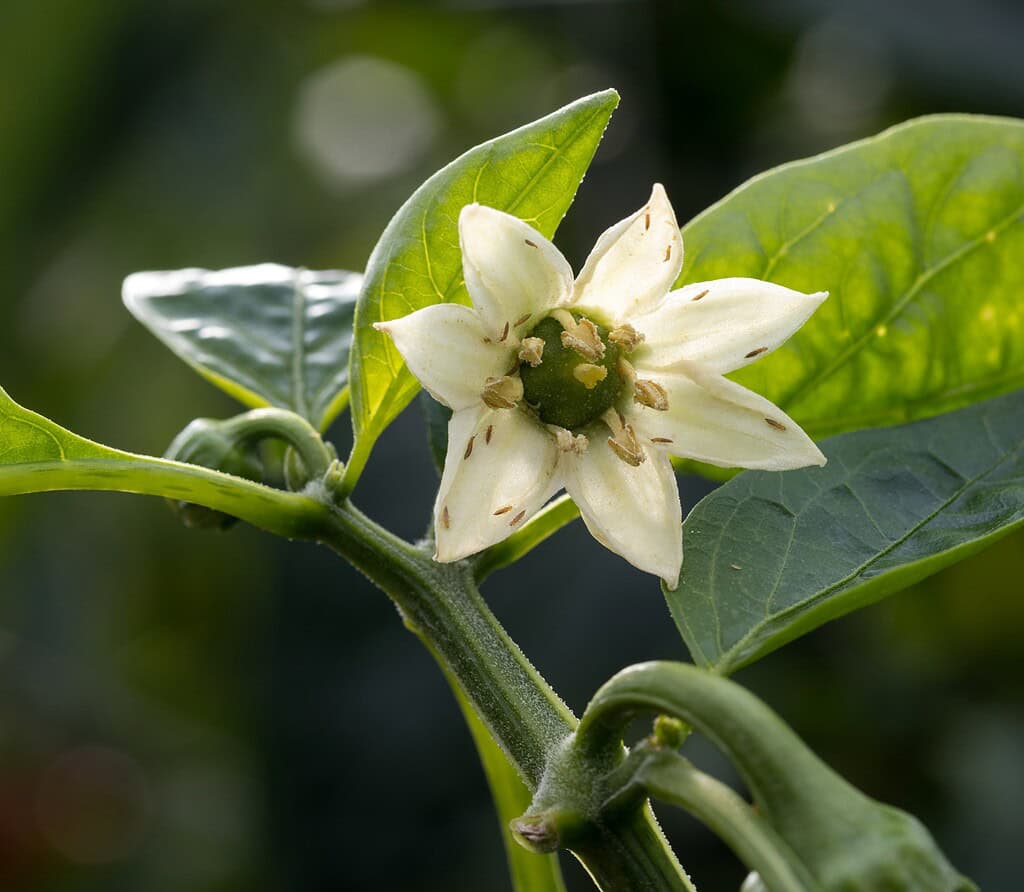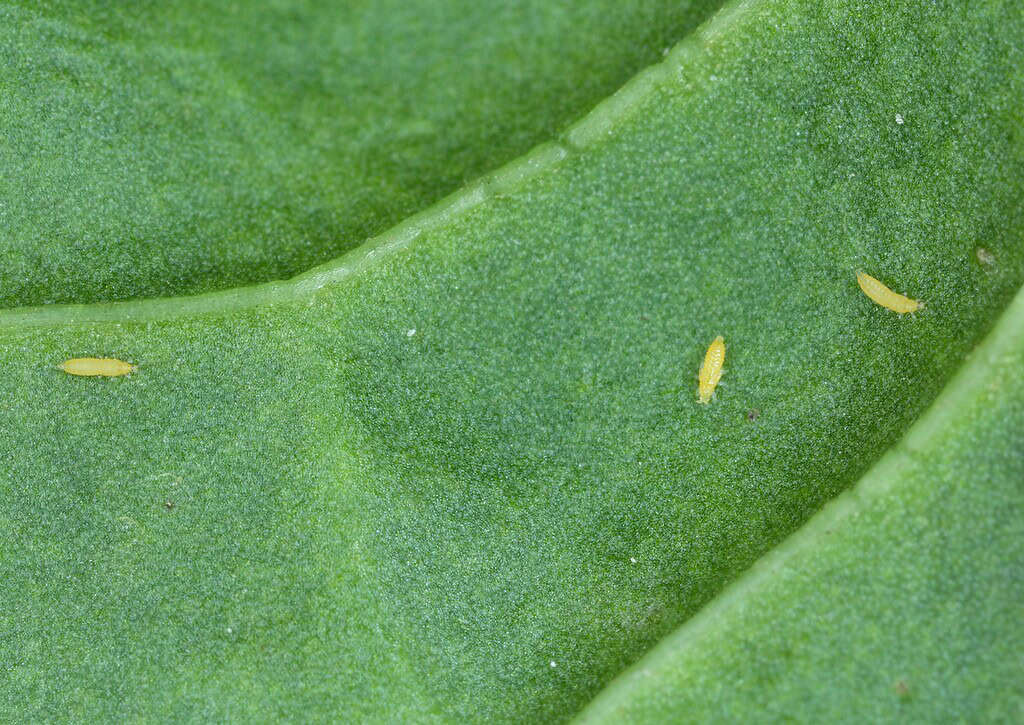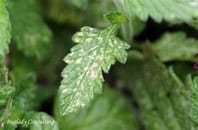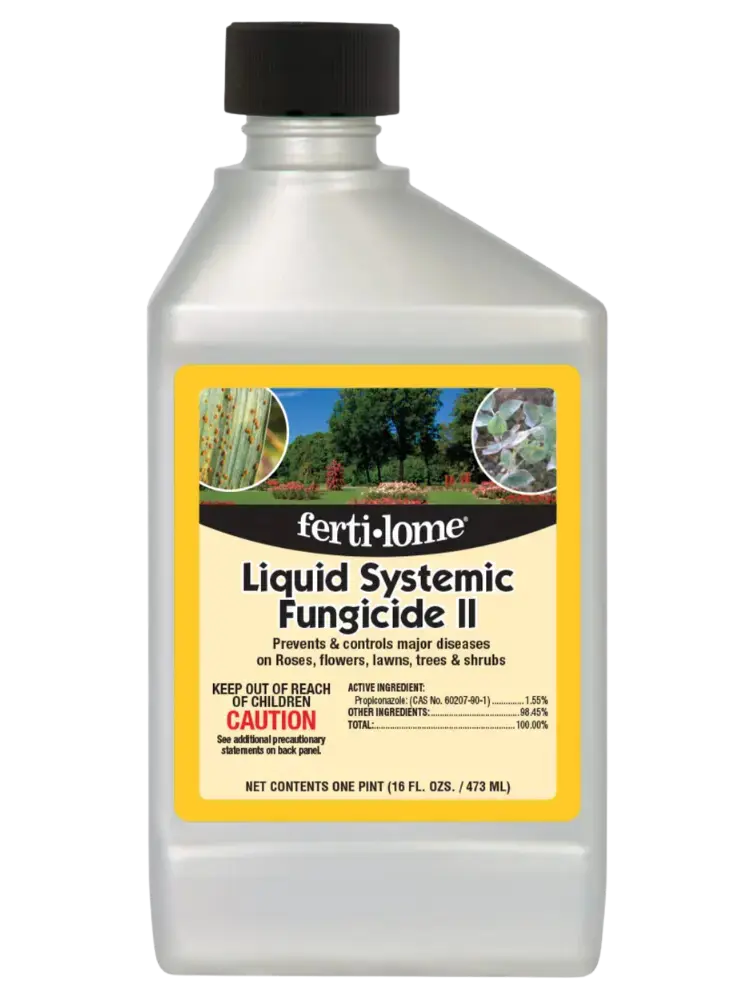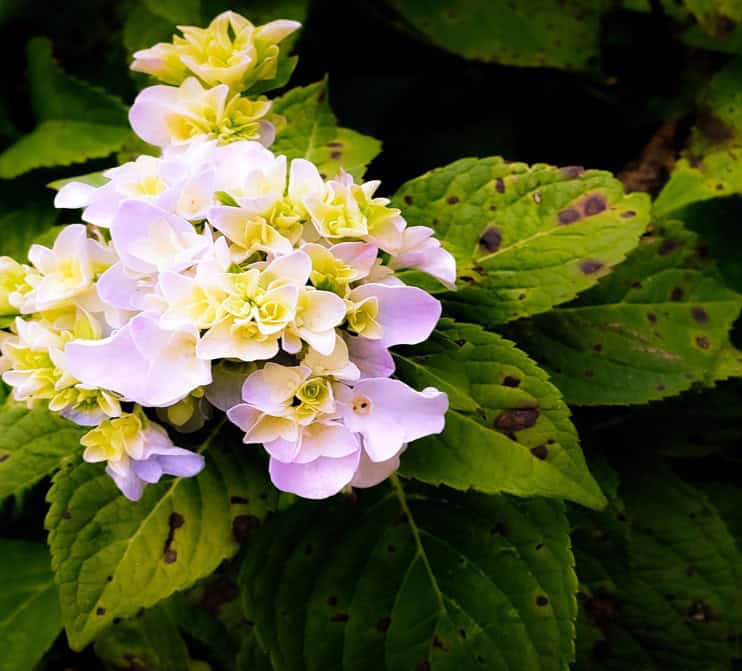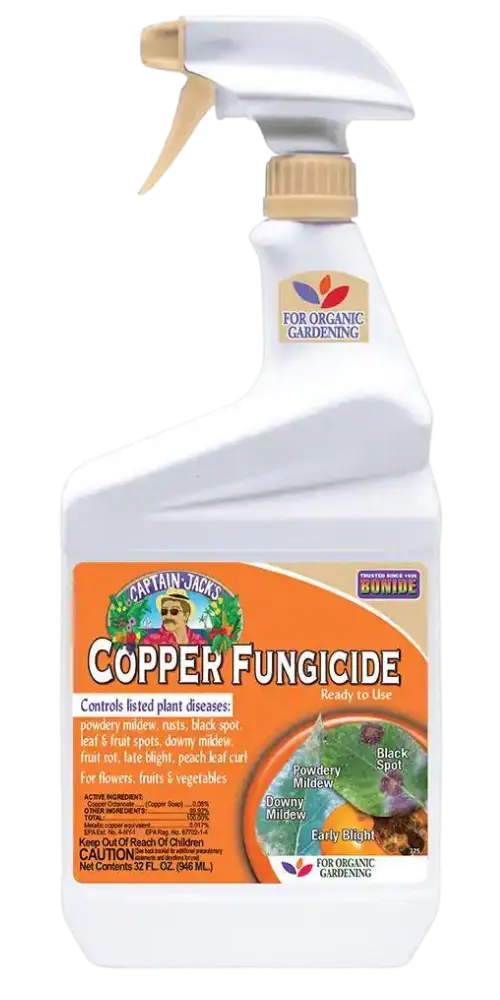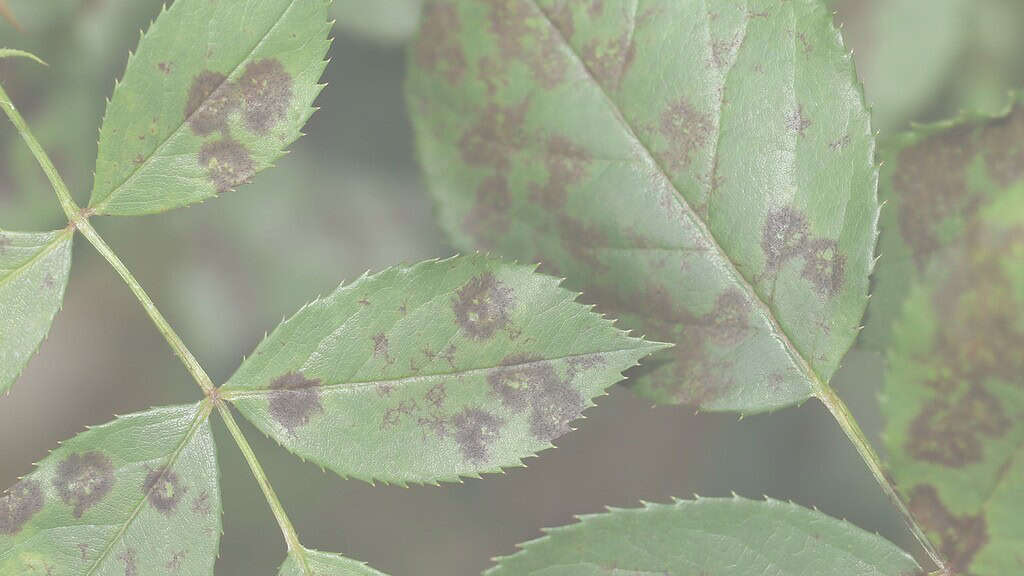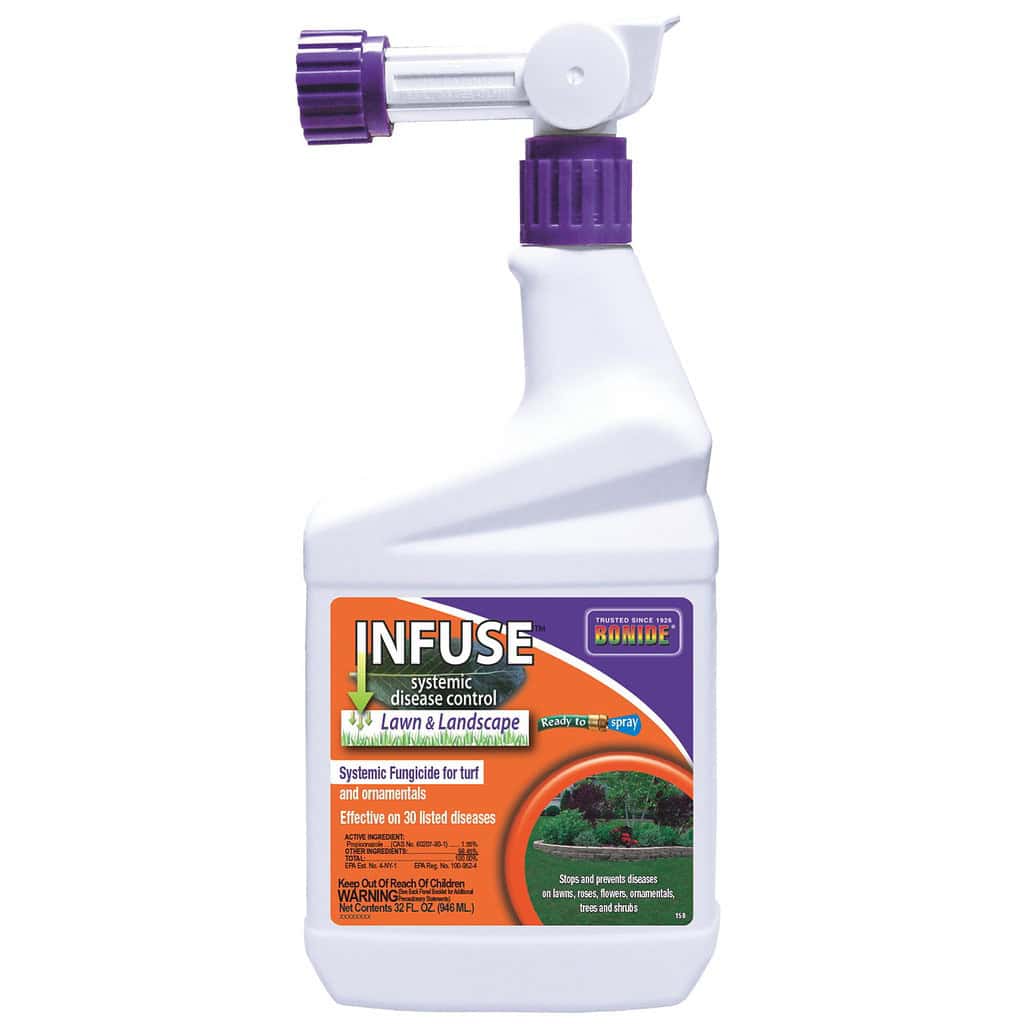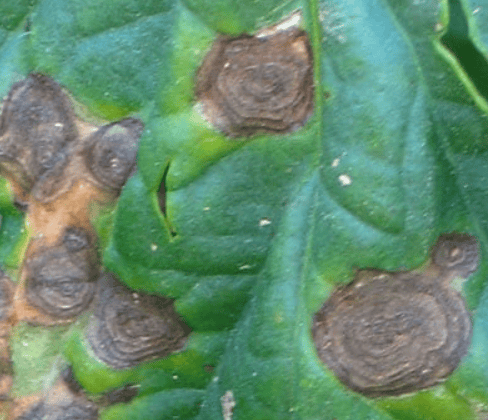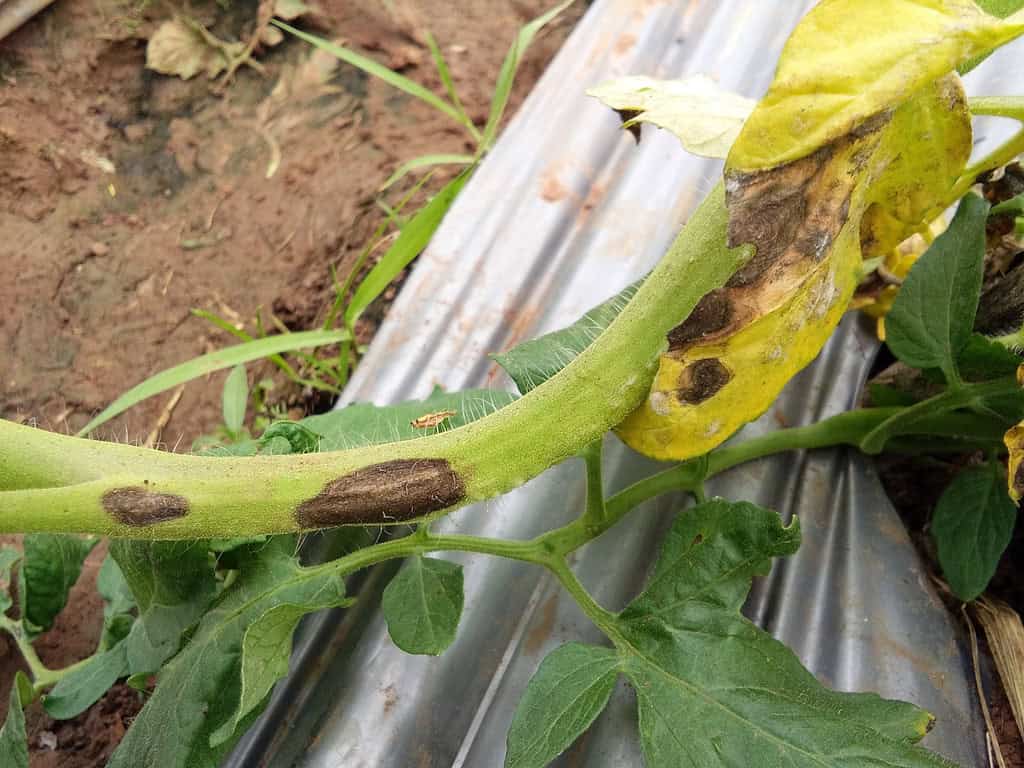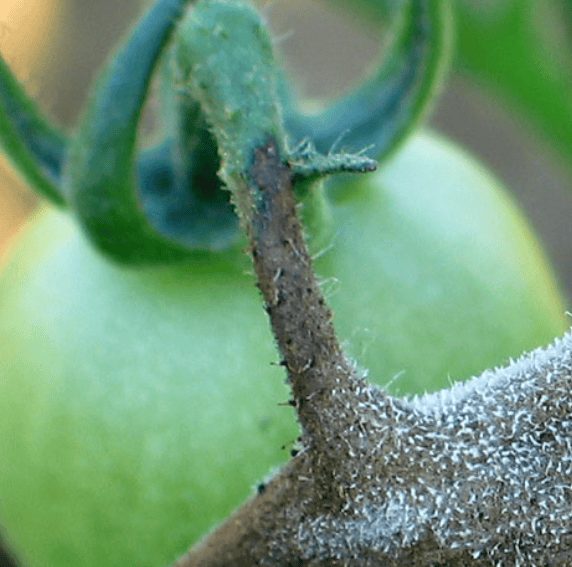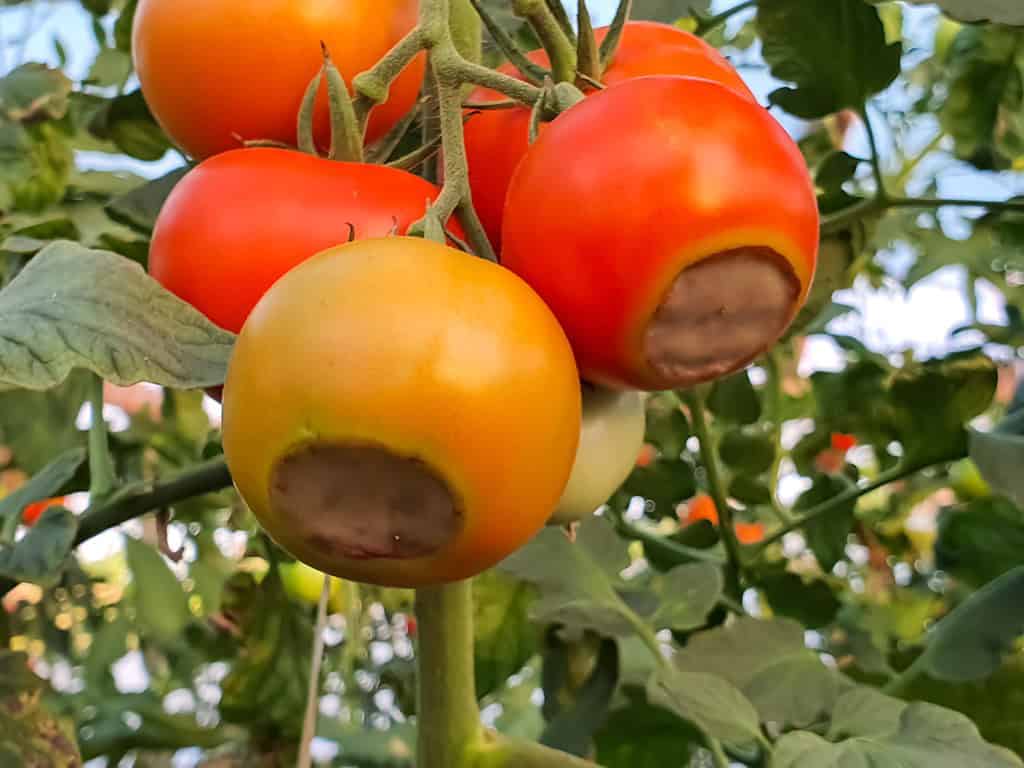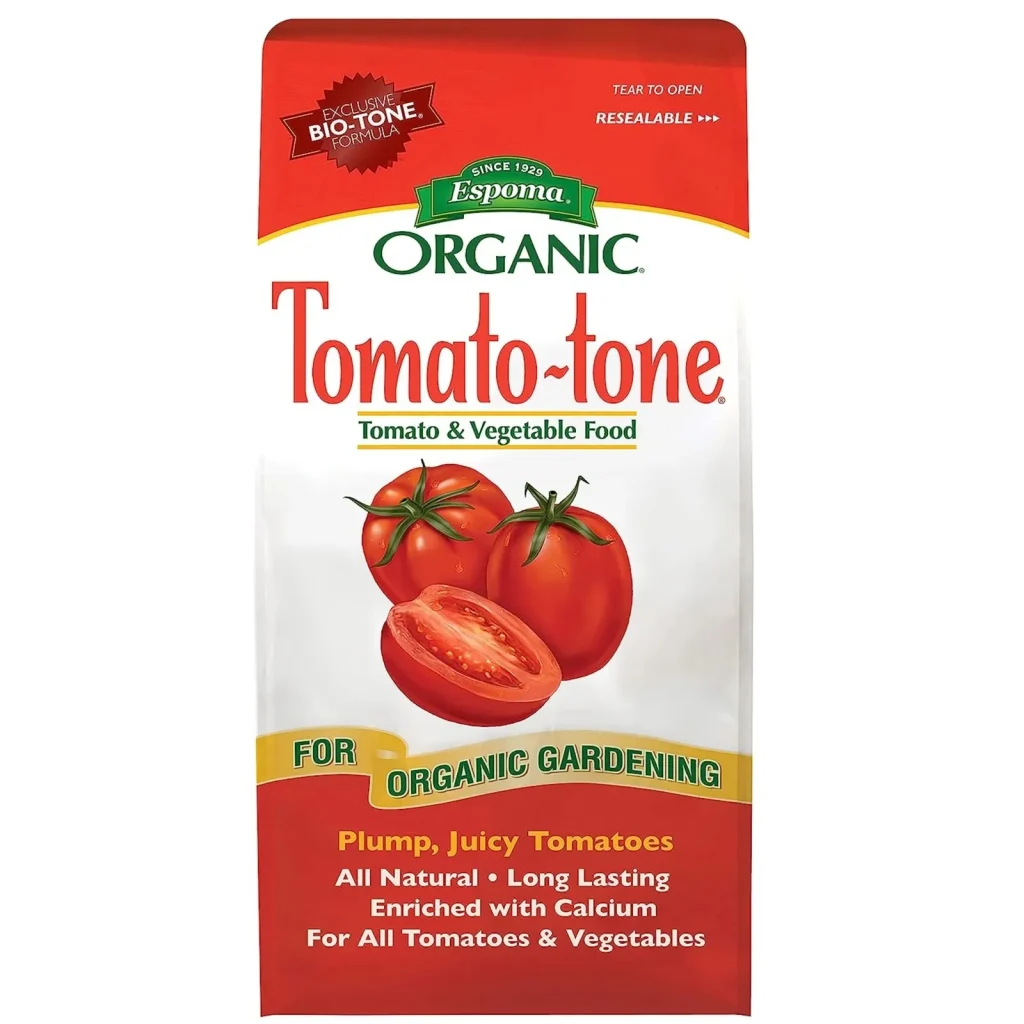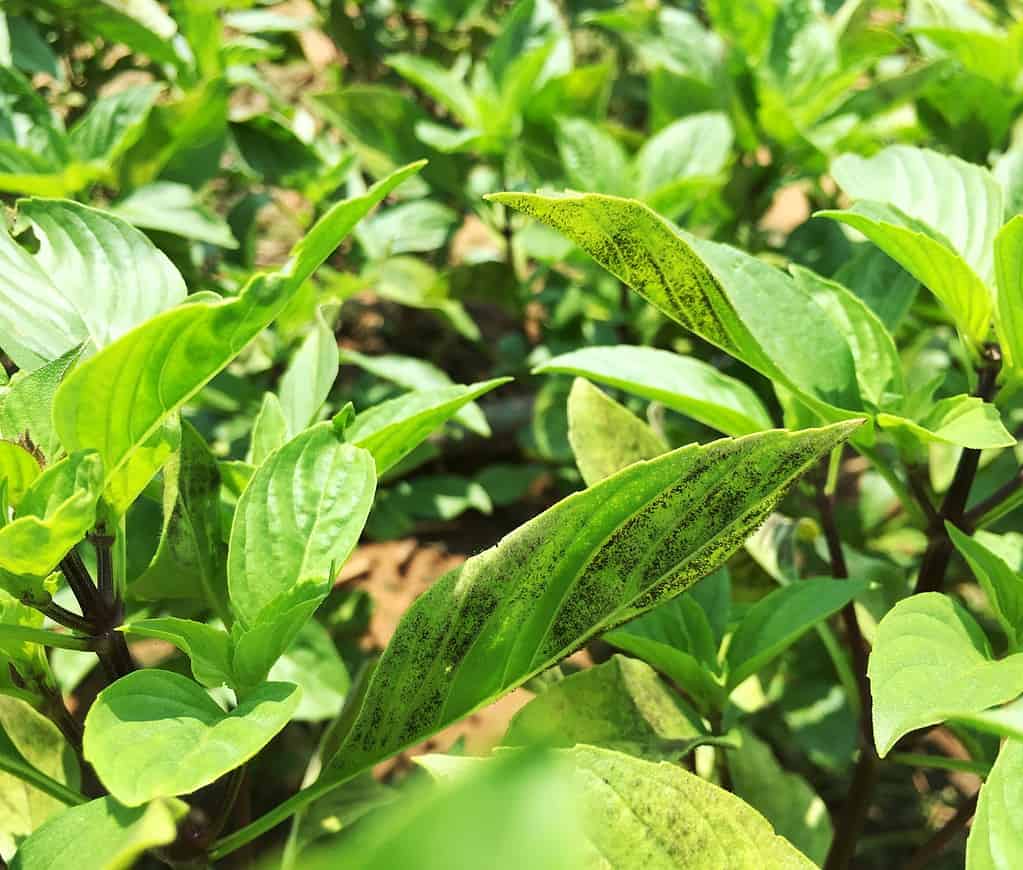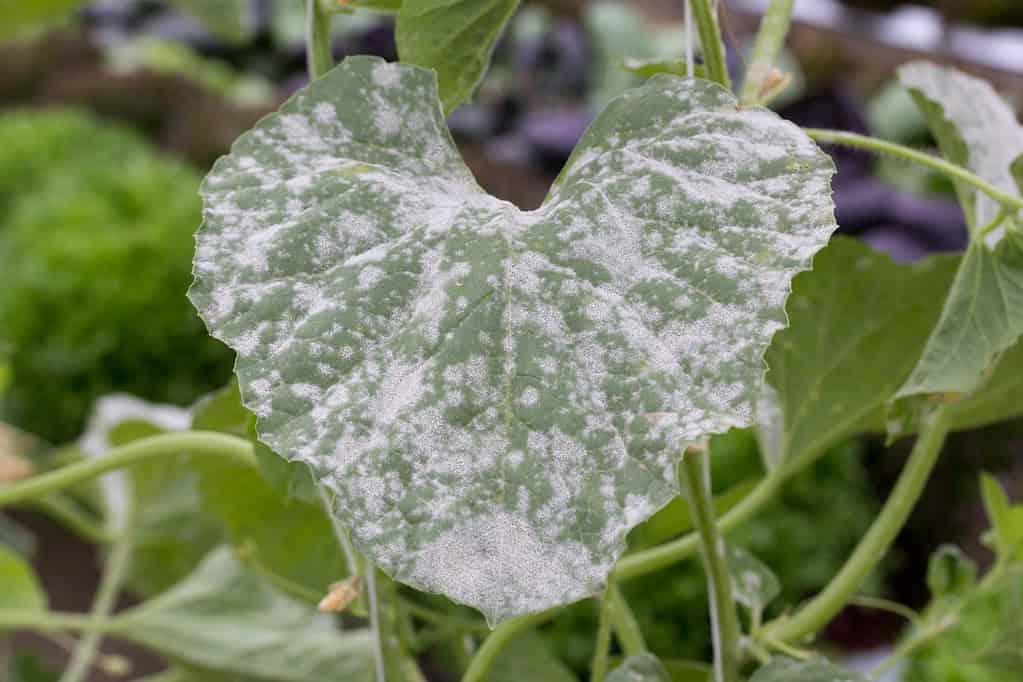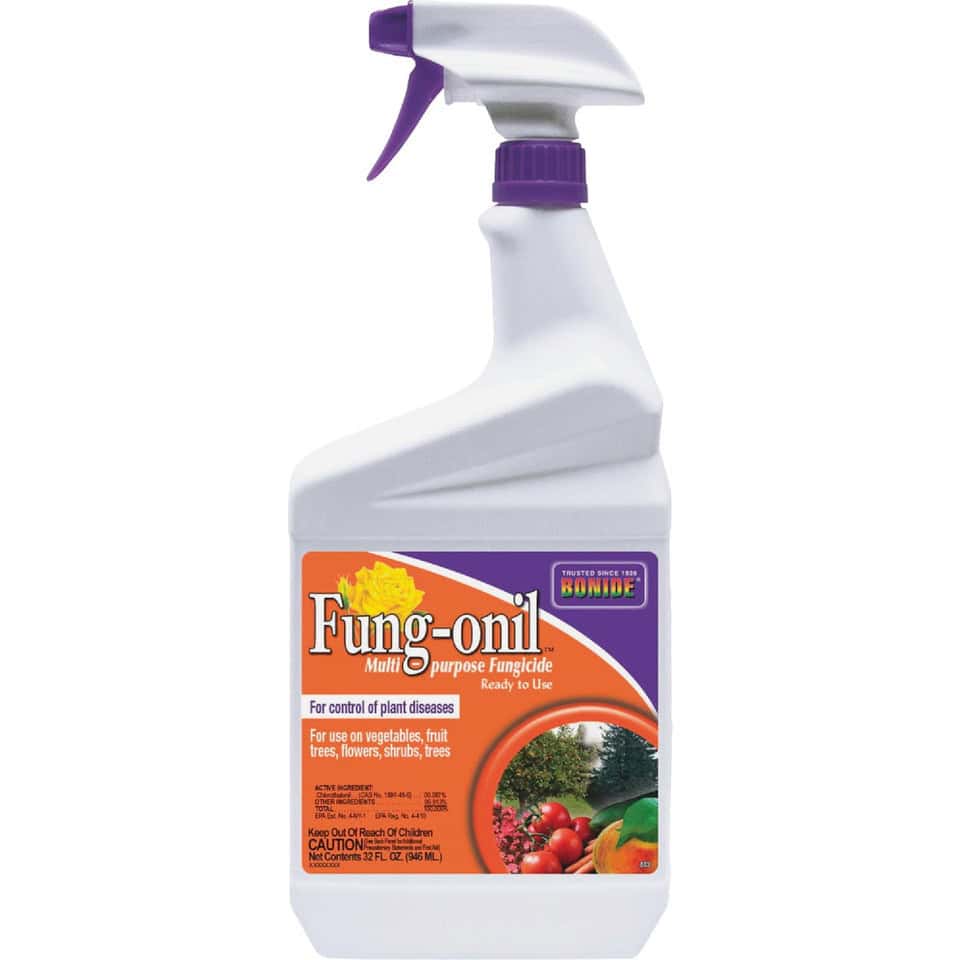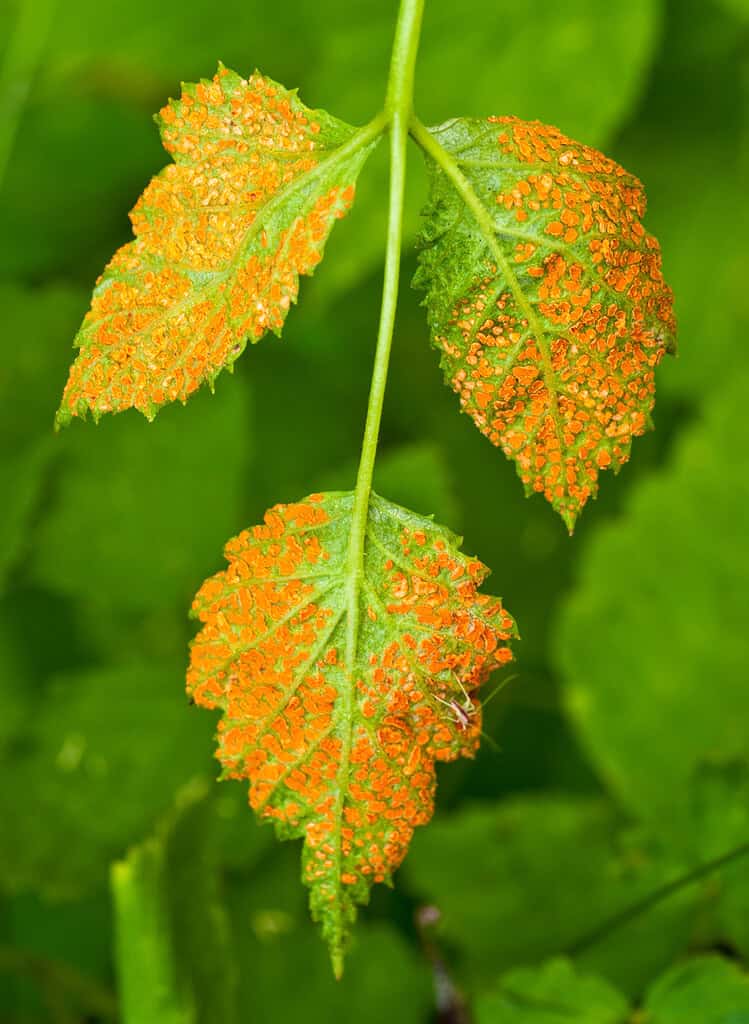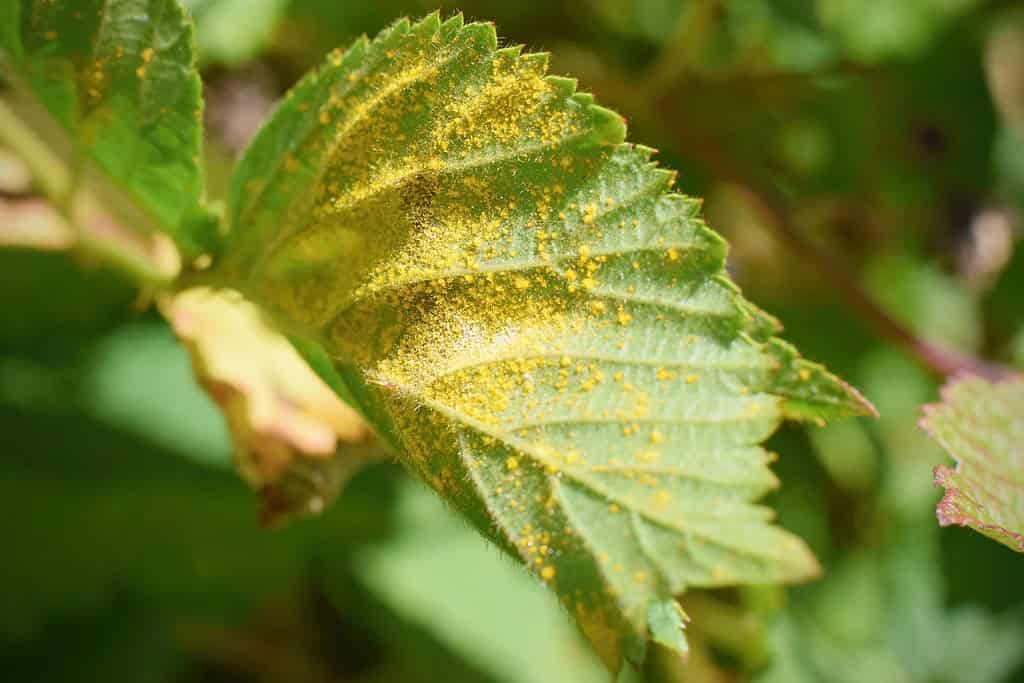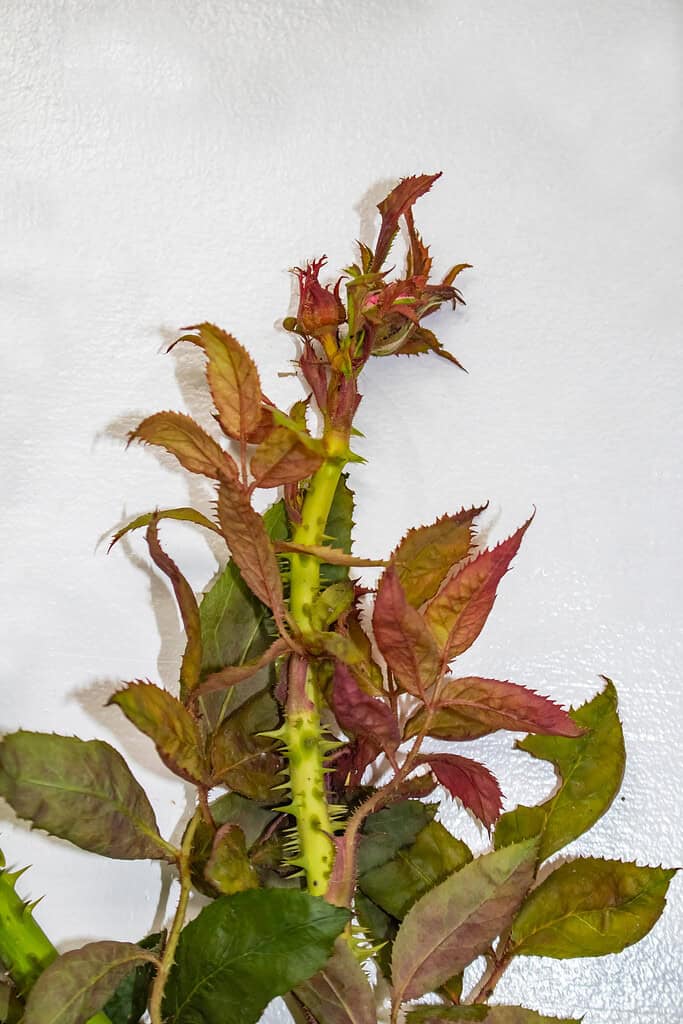Garden chemicals play a crucial role in maintaining plant health and productivity by controlling various pests and diseases. At Martin Garden Center, we carry a wide variety of Pesticides, Fungicides, and Herbicides to help you tackle any issue in your garden. Pesticides manage pests such as insects, insect-like organisms such as mites, mollusks (e.g., snails and slugs), rodents and other unwanted garden visitors (e.g., snakes, deer and rabbits). Fungicides prevent and control microbial organisms, including bacteria, viruses, and fungal diseases, such as botrytis, powdery mildew and leaf spot. Herbicides manage unwanted weeds that compete with cultivated plants for resources. We also carry a great selection of Soil and Fertilizer.
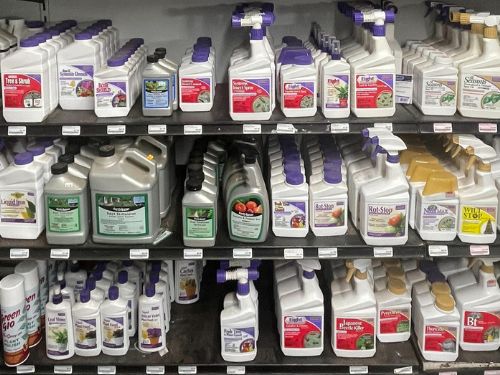
Common Pest and Disease Control
Effectively managing pests and diseases in your garden starts with accurate identification and understanding of the issues. Common Pests such as aphids, caterpillars, and beetles can cause significant damage to plants by feeding on leaves, stems, and roots. Diseases like powdery mildew, rust, and blight can weaken plants and reduce yields. Using the appropriate chemicals for these issues involves selecting insecticides for pest control and fungicides for disease management. For instance, insecticidal soaps are effective against soft-bodied insects like aphids, while systemic fungicides can control persistent fungal infections. IN OUR PARAGRAPHS THAT FOLLOW, we discuss each common insect, pest and fungus and identification, prevention and treatment strategies.
Regular monitoring of your garden is essential to detect problems early and apply treatments before infestations become severe. Look for signs of damage, such as chewed leaves, discolored spots, or stunted growth, and identify the pests or pathogens responsible before devising a treatment strategy.
Implementing integrated pest management (IPM) strategies, which combine chemical treatments with cultural, mechanical, and biological controls, can enhance the effectiveness of your pest and disease control efforts. For example, removing infected plant debris, encouraging beneficial insects, and practicing crop rotation can reduce the reliance on chemical treatments and promote a healthier garden ecosystem. By staying vigilant and proactive, you can keep your garden thriving and minimize the impact of pests and diseases.
Pesticides
Pesticides are chemicals that are formulated to target a variety of pests, including insects, mites, and rodents and other vertebrates, ensuring that gardens remain healthy and productive. Insecticides, a common type of pesticide, are specifically aimed at controlling insect populations such as aphids, beetles, and caterpillars, which can chew through leaves, stems, and fruits, compromising plant health. We additionally carry Miticides, Rodenticides & more.
Pesticides can be applied in various forms, including sprays, granules, and baits, depending on the pest and the specific needs of the garden. For instance, systemic insecticides are absorbed by plants and provide long-term protection against pests that feed on plant tissues, while contact insecticides kill pests on contact and offer immediate results. Gardeners must follow the manufacturer’s instructions and safety guidelines when applying pesticides to ensure effective pest control while minimizing risks to beneficial insects, pets, and humans.
Our Selection Of Pesticides
The list below provides the pesticides that we carry and their constituents according to their Material Safety Data Sheets. After this list, we will provide a summary of what pesticides to use for each pest. RTU means Ready to Use and RTS means Ready to Spray (must hook to a hose to spray).
- All Seasons Horticultural Oil Concentrate
- Annual Grub Beater Granules
- Annual Tree & Shrub Insect Control w/ Systemaxx Conc
- Bon-Neem® II Ready-to-Use
- Captain Jack’s Citrus, Fruit, & Nut Orchard Concentrate
- Captain Jack’s Fruit Tree Spray Concentrate
- Captain Jack’s Neem Max RTU w/Power Wand
- Captain Jack’s Neem Oil Concentrate
- Captain Jack’s Neem Oil Ready-to-Use
- Captain Jack’s Rose Rx 4 in 1 Ready to Use
- Annual Grub Beater Granules
- Annual® Tree & Shrub Insect Control w/ Systemaxx Conc
- Annual Tree & Shrub Insect Control w/ Systemaxx Conc
- Bt Bacillus Thuringiensis RTU
- Bug & Slug Killer
- Captain Jack’s DeadBug Brew® Concentrate
- Captain Jack’s DeadBug Brew® Dust
- Captain Jack’s DeadBug Brew® Ready-to-Spray
- Captain Jack’s DeadBug Brew® Ready-to-Use
- Captain Jack’s Fruit Tree Spray Concentrate
- Diatomaceous Earth – Use as a barrier around plants susceptible to crawlers.
- Eight Flower & Vegetable Soil Insect Granules
- Eight Garden & Home Ready-to-Use
- Eight Insect Control Garden Dust
- Eight Vegetable, Fruit, & Flower Concentrate
- Eight Yard & Garden Ready-to-Spray
- Eight® Flower & Vegetable Soil Insect Granules
- Eight Garden & Home Ready-to-Use
- Eight® Insect Control Garden Dust
- Eight Vegetable, Fruit, & Flower Concentrate
- Eight® Yard & Garden RTS
- Eight Yard & Garden Ready-to-Spray
- Fruit Tree & Plant Guard Concentrate
- Insecticidal Soap RTU
- Insecticidal Super Soap RTU
- Insect Control
- Japanese Beetle Bagger Bags
- Japanese Beetle Bagger Lures
- Japanese Beetle Bagger Trap Kit
- Japanese Beetle Killer RTU
- Mosquito Beater Granules – Summit product consisting of 2.86% Bacillus thuringiensis subspecies israelensis, Strain SUM 6218 and 97.14% other ingredients (not classified trade secret).
- Mosquito Beater Dunks – Summit product consisting of 10.31% Bacillus thuringiensis subspecies israelensis, Strain BMP-144 and 89.69% other ingredients (not classified trade secret). Hmmm.
- Pyrethrin Garden Spray Concentrate
- Rose Shield Systemic Rose & Flower Care Granules
- Rose Shield™ Systemic Rose & Flower Drench
- Slug Magic® Granules
- Stink Bug Traps
- Systemic Granules Insect Control
- Systemic Insect Control
- Systemic Insect Control Concentrate – Bonide product consisting of Acephate
- Systemic Insect Spray RTS
- Systemic Insect Spray Ready-to-Spray
- Systemic Rose & Flower Care Granules
- Repels All Animal Repellant – Bonide product consisting of
- Rose Shield Concentrate
- Rose Shield RTU
- Systemic Houseplant Insect Control
- Thuricide Concentrate – Bonide product consisting of concentrated BT (Bacillus Thuringensus).
- Triple Action – Fertilome product consisting of 70% Clarified Hydrophobic Extract of Neem Oil & 0.25% Pyrethrins. We carry RTU 32 oz, RTS 40 oz, Concentrate 16 oz and Concentrate 8 oz.
Summary By Pest (Alphabetical)
Aphids – You will usually find aphids hiding on the underside of leaves. They are soft bodied insects that come in colors, commonly pale green, bright yellow, and black and, uncommonly, can be found in colors of white, brown, gray, orange or even pink! Aphids go from nymphs to adults in 7-10 days. Aphids molt 3-4 times until reaching adulthood.
Tiny white strips of shredded skin on foliage are the first indication of the presence of Aphids. More extreme infestations have a gritty look to foliage caused by feeding. Aphids feed by piercing the underside of leaves and sucking the juices. The waste product of this process is high in sugars and is called honeydew. Honeydew leads to sooty mold on leaves so look for sooty mold. Also look for ants attracted to honeydew and ladybugs who eat aphids.
Aphids are discriminate. Once they establish with one plant, they more or less stay with it (until it is no longer available). This is good and bad. It’s good because if you find Aphids on one Lemon Slice Calibrachoa plant, they have probably traveled to other nearby Lemon Slice Calibrachoas and will prefer this food over other plants including other Calibrachoas. It’s bad for the same reason because one aphid reproducing for several generations can infest entire crops of plants.
Aphids are born pregnant, and when they begin reproducing, they can generate 80 offspring each week resulting in 320 offspring during their 4-week life span. Obviously, their reproduction is exponential. After 4 weeks, if all offspring reproduce at the same rate, you are dealing with more than 42 million aphids.
| Generation | 1st Generation | 2nd Generation | 3rd Generation | 4th Generation | Total of 4 generations |
| # of Aphids | 1 Aphid | 80 Aphids | 6,400 Aphids | 512,000 Aphids | Total Aphids |
| Week 1 | 80 | ||||
| Week 2 | 80 | 6,400 | |||
| Week 3 | 80 | 6,400 | 512,000 | ||
| Week 4 | 80 | 6,400 | 512,000 | 40,960,000 | |
| Sum of Each Generation | 320 | 19,200 | 1,024,000 | 40,960,000 | 42,003,520 |
Aphids enjoy most plants, but at Martin Garden Center, we’ve found they prefer hibiscus, mandevilla, bougainvillea, vines, ajuga, pansies, asparagus fern (sprengeri), mums, fall ornamental veggies, fall edible veggies, crepe myrtles, bearded iris, Asiatic lilies, daylilies, calibrachoa, mazus, monarda, nicotiana, roses and milkweed (DEAR READER … YOU MUST READ MORE ABOUT PROTECTING MILKWEED).
Aphids love milkweed particularly the orange aphid (oleander aphid (Aphis Neri). As most readers know, milkweed is the primary food source for the caterpillar of the monarch butterfly, which is an endangered species. Consequently, if your milkweed gets Aphids, DO NOT use chemicals because if you do, the pesticides will kill any Monarch caterpillar that feed on the milkweed. Instead, if removal of aphids from milkweed is your goal, jet blast them off with high pressure water or squish them. You can also pinch off new growth pieces that tend to have high concentrations of Aphids and throw them in the trash.
Outside of the Aphids on Milkweed, Aphids are easily treated with any form of Insecticidal Soap, which melts their outer skin and desiccates them (they deserve it). At Martin Garden Center, we combine Insecticidal Soap with Neem Oil with Pyrethrins for a triple whammy. If you treat for Aphids, also note that Aphids reproduce within 7 days and most of your over-the-counter Pesticides suggest waiting 7 days to treat again. But, if you wait 7 days, this may result in another generation of Aphids. Hmmm … what to do? Break the rules or don’t break them, we won’t judge you. We’re just here to give you facts and statistics.
When treating for Aphids, over the counter Bonide’s Insecticidal Soap and Ferti-lome’s Triple Action are great in combo for killing Aphids, but if you don’t mix your chemicals, stick with Bonide’s Insecticidal Soap or Bonide’s Supersoap (Insecticidal Soap combined with Spinosad).
Imidacloprid, which we carry in Bonide’s Systemic Granules Insect Control, is also a great eradicator/preventer of Aphids. At Martin Garden Center, we use Imidacloprid on those plant starts that are susceptible to Aphids, and on non-blooming Aphid attractors. It protects them for circa 60 days. This is often enough time to keep the plant safe from the predator before they can be moved outside where concentrated Aphid populations are less likely.
Note that Acephate, the active ingredient in Bonide’s Systemic Insect Control Concentrate, is the other go-to when it comes to Aphid eradication. We also like Acephate because it eradicates other problem pests and gives the sprayed plants a big phosphorous boost.
Be aware that Imidacloprid is a neonicotinoid, which is a well-known Bee Killer. We use great reserve when using it and recommending it. Specifically, we only use it on plants that do not flower, or plants that will not flower within the 60-day residual period. We likewise recommend the same.
There are several other pesticides that indicate that they kill Aphids. And they do. Just not as effectively as the aforementioned.
Army Worms – Then, there are army worms which we hope you never encounter. Armyworms are the larvae of several moth species and can be identified by their distinctive green, yellow, red, or brown stripes running down their sides and backs. One of the most recognizable features is the inverted “Y” mark on their head. These caterpillars can grow up to 1.5 to 2 inches long. They are most active at night and hide under debris or in the soil during the day. They often overwinter in lawn areas (look for brown sod), and feed on the roots of grass until spring arrives.
Army worms travel in mass and are notorious for their destructive feeding habits. They can devastate lawns, crops, and gardens in a short period. These pests consume everything in their path, which is why they are called “armyworms.” To prevent damage from armyworms, regular monitoring and early detection are crucial. Hand-picking and destroying egg masses and larvae can help in small infestations. Encouraging natural predators like birds and beneficial insects such as parasitic wasps can also reduce armyworm populations. For larger infestations, apply insecticides like BT and Acephate. AI also suggests Spinosad or Neem Oil.
Asian Longhorn Beetle (ALB) – The Asian longhorned beetle (ALB) is an invasive insect that attacks hardwood trees. The insect lays eggs and the larvae grow inside trees and feeds on the living tissues. Trees cannot heal from the damage ALB causes. In sum, once infected, trees will die. Consequently, prevention is the only recourse and permethrin (active ingredient in Bonide’s Eight) is our chemical of choice.
Every spring, after the temperature rises and there have been three days in a row where the temperature rises above 70F degrees, we begin spraying the trunks of the trees on our treeline with Permethrin. We continue spraying the tree trunks for 8-12 weeks. In the fall, when temperatures fall below 80F degrees, we do it again for 4-6 weeks.
This approach has been extremely effective for us in protecting our ornamental trees from infection, but as a homeowner, you have to question whether this approach is viable for you.
Another approach is using Imidacloprid, a neonicotinoid. Neonic’s are commonly referred to as the “bee killer” because they have been found, when sprayed upon flowering trees, all the bees dropped dead. Definitely a bad thing. However, the neonic industry claims that when used as a drench and absorbed into the plant tissue, the neonicotinoids don’t reach the flower and therefore can’t harm the bee. We don’t have empirical evidence either way, but at Martin Garden Center, when we use Imidacloprid, we use it on non-flowering plants or 60-days prior to the plants flowering period.
Again, what will work for a homeowner? We can provide options and information, but we can’t make the decision for you. One very important point to make … if you buy a healthy tree, and ALB is not present in your neighborhood, then you don’t need to protect your expensive ornamental trees from ALB. But, if any neighboring homeowner has had issues, then then entire neighborhood has the potential to lose plants to ALB.
Clemson Extension has an informative summary on ALB (see the link below). Note that their summary is somewhat misleading because it suggests ALB only goes for certain hardwoods and that ALB is limited to certain counties. The unfortunate truth is that the ornamental tree industry was hard hit circa 2017 ish by ALB but the preventive measures (e.g., pyrethroid weekly sprays) addressed the issue in reputable nurseries in 2 or so years, but it did not eliminate the bug which has spread throughout the country.
Bagworms – Bagworms are destructive caterpillars that primarily feed on evergreen shrubs, commonly junipers, arborvitae, spruce, and pine and can also be found on deciduous trees like maple, oak, willow and other trees and shrubs. We found one hanging on the soffit of our building … yeesh.
The female bagworm moth (Thyridopteryx ephemeraeformis) is wingless and carries her bag around with her. After mating, she lays between 500 to 1,000 eggs within her lifetime. The eggs overwinter inside the bag and hatch in late spring to early summer. When the larvae are hatched, they produce long strands of silk that then catch the wind and disperse the larva over considerable distances. This process is called ballooning and is the main way that bagworms get around. Although, bagworms can crawl from one plant to another.
Identification of bagworms is relatively straightforward: the larvae construct spindle-shaped bags made of silk and plant material, which they carry with them as they move. These bags can reach up to 2 inches in length and are often mistaken for pinecones or other plant debris. When infestations are severe, the foliage may appear sparse, and areas can become completely defoliated.
Treatment and prevention of bagworms involve several approaches. Physically removing the bags by hand is effective, especially in smaller infestations. This should be done during the winter or early spring before the larvae emerge. Chemical control is another option; organic insecticides such as Bacillus thuringiensis (BT) or spinosad are effective when applied on the insects in late spring to early summer while the larvae are still small. For larger infestations, non-organic systemic insecticides like Imidacloprid can be used. We carry BT in three forms all of which are organic. Bonide’s BT is an RTU. Bonide’s Thuricide, which is also BT, is a concentrate. And, Bonide’s Dipel Dust is also BT albeit dust. We carry Spinosad as part of Bonide’s Captain Jack’s Dead Bug Brew and also Bonide’s Captain Jack’s Supersoap, all organic.
Preventative measures include maintaining plant health through proper watering and fertilization, as stressed plants are more susceptible to bagworm infestations. Regular monitoring and early detection are crucial for effective management, as early intervention can prevent significant damage.
Budworms – Budworms are small worms that warrant their own narrative. Budworms usually show up around mid-May in the Upstate SC. They are spread by the tobacco budworm moth (Chloridea virescens), which lays eggs on unsuspecting outdoor plants everywhere. When these eggs hatch, the little budworms less than 1/16-inch-long start feeding on the most tender part of the plant, the buds and petals of the blooms. If you are observant, you will see the beginning of the budworm damage starting with tiny/small holes in the petals of the blooms. But the damage doesn’t stop there. These voracious little feeders can and will multiply and grow, feasting on every tender blossom of your beloved plants.
We’ve found budworms to be particularly problematic on Bacopa, Brachyscome, Calibrachoa, Dahlia, Petunia, and Zinnia. Note that AI generated geraniums and nicotiana as problematic, but we’ve not had issues with these plants and budworms.
With budworms, the problem is all about aesthetics because budworms only eat the tender petals of blooms. We’ve found that the plant will recover once the budworms move on to the pupa stage, followed by new moths, then new eggs etc. However, information sources fairly warn us that budworms may stunt the growth of your flowering plants because they also eat the tender new growth. True that!
In the South, we can expect 2 life cycles if the budworms are not stopped. If left unchecked floriferous plants can reduce or even stop blooming in late May/early June and then again in late August, early September, with the second set of worms being larger and far more devastating.
With budworms, timing is everything. If you catch them and treat them with BT (see the discussion under caterpillars and worms) when they are 1/16 inch long and before they reach 1-2 inches, you can save a lot of blooms. Once treated, your blooms will be restored in 1 or 2 weeks after treatment. Left untreated, your blooms may return in about 4-6 weeks … if your plant survives.
Caterpillars and Worms – Caterpillars and worms are indiscriminate, and they will go for any and every plant. And, because every moth and butterfly can fly, all plants are accessible. Often the caterpillars and worms come out at night to feed, but even if they feed during the day, they are oftentimes camouflaged because they are green like the plants. Green colors are predominant among worms to hide amongst green foliage, but brightly colored worms & caterpillars are common. The most common way to identify worm and caterpillar damage is to look for holes in leaves and flower petals.
Damage from caterpillars and worms is seasonal, at least for outside plants. Generally, moths and butterflies don’t begin to become prolific until mid-spring. And, at that time they begin laying eggs on anything and everything.
Indoor & outdoor ferns are another big target for worms and caterpillars at Martin Garden Center. For indoor ferns, year-round watch for brown poop (pinhead size) below ferns and for gnawed and misshapen new fronds as indicative of worms and caterpillars feeding on ferns.
At Martin Garden Center, the worms and caterpillars particularly like veggies. We don’t see problems on spring veggies until early summer because the butterflies and moths don’t begin laying eggs until late spring and their spawn, the worms and caterpillars don’t begin feeding until early summer (and by that time, we’ve sold through our spring veggies). But fall veggies … Yeesh!!! The worms and caterpillars will go rampant on untreated fall veggies as is evidenced by holes in foliage.
So how do you defeat these pests? First, once you see signs of worms and caterpillars, you can physically remove and squish them. Consider night raids using black lights that will make the caterpillars and worms glow. Second, for most worms and caterpillars, treat them with BT, which is organic in all three forms. We carry Bonide’s Bacillus Thuringensis (BT) RTU, Bonide’s Thuricide (also BT but in concentrated form requiring dilution with water) & Dipel Dust (which is also BT in dust form that can be easily spread with a flour sifter). We like BT versus other chemicals because BT is selective … it kills the caterpillars and worms but it does not affect the beneficial insects.
At Martin Garden Center, we spray regularly with BT to protect our ferns and prevent damage. We also apply BT in the form of Dipel Dust on our fall vegetables each week. Some of the worms, however, may not respond to BT. For example, we’ve found that cut worms may require Acephate (Bonide’s Systemic Control) and Army Worms are best treated, particularly in lawns, by applying Permethrin (Bonide’s Eight) to blades of green grass in the pathway of the horde. Preventatively, in the early spring, Imidacloprid used as part of grub control (Bonide’s Grub Control) in lawns, has been used to kill the larvae of cutworms and armyworms as well as other pest larvae (i.e., Japanese Beetle).
Know Your Friend – There are some plants that we would encourage moths and caterpillars to eat. Specifically, parsley, celery, fennel, passion flower vine, baptisia and milkweed which are important food sources for caterpillars of tiger and swallowtail butterflies, as well as some endangered species of butterflies.
Cats and Dogs – While not a pest per se, cats and dogs can wreak havoc in gardens, particularly if you have a digger or a gnawer. Martin Garden Center does offer Bonide’s Repellant for Cats and Dogs if homeowners believe it is necessary.
Chipmunks and Squirrels – Chipmunks and squirrels, while often viewed as charming woodland creatures, can be significant pests in gardens. These small mammals are notorious for their foraging behaviors, which can lead to extensive damage to garden plants and vegetables. Chipmunks, with their cheek pouches, dig up bulbs, nibble on tender shoots, and stash away seeds, causing both immediate and long-term damage to gardens. Their burrowing habits can also disrupt the root systems of plants, leading to stunted growth or plant death.
Squirrels, being agile climbers, can decimate gardens by eating fruits, vegetables, and nuts. They often strip bark from trees and dig up newly planted seeds, looking for food or burying their own. Squirrels are particularly troublesome in fruit gardens, where they can quickly destroy entire crops of berries, apples, and other fruits. Both chipmunks and squirrels are also known to gnaw on irrigation lines and garden structures, causing additional damage. Effective management strategies include physical barriers, such as fencing or netting, and using repellents or live traps to reduce their impact on gardens.
Detering these little buggers can include erecting physical barriers, using repellents, and capsaicin, peppermint oil, or predator urine. At Martin Garden Center, we carry Bonide’s Repels All Animal Repellant in 3lb granular.
We also carry and we highly recommend Pepper Spray, which burns the lips of the consumer of your plants. Remember, it will burn the lips of one consumer who will learn their lesson, but the 20 other consumers in the herd may not learn by example. So, be diligent and spray repeatedly. Over time, the little wankers will learn.
Cutworm – Another problem worm, this one spread by moths, is a cutworm. Look for severed stems or hacked stems at or near soil level. At Martin Garden Center, we’ve found these buggers on perennial vinca vine and Sunflowers. AI says they like vegetables but also target grasses, herbs, fruits, ornamentals, and even weeds. But, we’ve never encountered them on such.
Unfortunately, there are usually no warnings that cutworms are present … just severed stems the morning after they feed at night. Consequently, be ready to treat immediately upon noticing such. AI suggests use of BT, but we didn’t find BT 000successful, so we used Acephate (Bonide’s Systemic Insect Control). Remember, if you don’t treat early, they continue severing stems and retarding or killing your plants.
It takes a while for a plant to recover from cutworms so early identification is key to preventing them from further damaging your plant or other plants in the area. Prevention methods include removing weeds and grass (which are often where legs are laid) from growing areas, as well as thoroughly tilling soil to rout out and kill any grubs that are overwintering in the soil.
Deer – Talk about big pests … Egads. Deer love hosta and hydrangeas, but when they are hungry, they’ll eat anything. There are deer “resistant” plants, but deer will even munch on these if hungry. At Martin Garden Center, we definitely have deer invasions. Consequently, we use deer repellant at the first sign of deer.
Deer are creatures of habit and once they establish their pattern of moving through your property, they continue on unless their pattern is disrupted.
We have had success with Bonide’s Repels All Animal Repellant as well as Liquid Fence (which smells badly). And yes, we use Bonide’s Pepper Spray to keep them away from our pansies in the early winter. At Martin Garden Center, we have marauding deer populations given that we are located next door to a nature preserve. This year, we added Summit’s Deer Ban Capsules which are water activated and supposedly are odorless to humans. Haven’t tried it yet but we will and we’ll let you know.
Dogs – See Cats and Dogs above
Flea Beetles – There are holes in leaves caused by several different pests such as the Japanese beetle or worms/caterpillars or other flying and munching insects (including grasshoppers). But none is as big of a pain in the toucas as the flea beetle which became problematic in the Upstate about 2018 ish.
The Flea Beetle is a small black beetle, about 1/16 to 1/4 inch in size. It’s life cycle from egg to adult is about 3 weeks which is long for most problem bugs. However, it lives for several months and can cause a lot of devastation in its lifetime.
The name Flea Beetle came from its ability to jump from plant to plant like a flea when you try to catch it, making it difficult to kill by hand. They are tough on ornamental shrubs, but they are devastating on food crops grown in mass.
At Martin Garden Center, we’ve found the Flea Beetle on a lot of different cultivars. The plants most often compromised include:
- Hydrangeas (particularly paniculata types)
- Lilacs
- Azaleas
- Perennial/hardy swamp hibiscus
- Zinnia
- Red Twig Dogwoods
- Sweetspire (Itea)
- Butterfly bushes
- Tea Olives
Flea Beetles lay their eggs in the mulch of their target plant (or in the loose organic debris in container plants). So, one our preventative measures is to remove excess leaf debris from plant containers.
We do not spray preventatively for Flea Beetle. Instead, we spray the affected cultivar immediately upon finding one beetle (because if there is one, there are more). We used to have an outbreak of Flea Beetles after receiving a shipment of hydrangeas, but preventative measures at our vendors are now common practice.
At one point, use of Permethrin (Bonide’s Eight) eliminated them. But they built up an immunity to Permethrin so over the last several years, the only over the counter chemical that we carry that will kill Flea Beetles is Acephate (Bonide’s Systemic Insect Control concentrate). In the last year, recent studies have shown that use of an Imidacloprid application in the early spring (mid-March) will kill larvae that have overwintered in containers. So, our vendors have used it, and we have used such and it has worked on the plants we have overwintered. Halleluiah! Perhaps this nuisance will finally be controlled, and we can go on to live a Flea Beetle free life!
Gnats – Fungus gnats are nuisances, but fungus gnat larvae are killers. Adults lay eggs in the top 2 inches of moist soil. Larvae, when born, will eat the young tender roots of our plugs and carry a host of diseases that ultimately kill plants. And, since we often must keep the soil moist at the top of containers when plugs are recently planted, gnats have the potential to be ever present.
Fungus gnats go from egg to adult in 7-14 days. They live 10-25 days and females often lay several batches of 50-100 or so, for approximately 500 eggs total in their lifetime.
Because we plant large scale and we must keep the top of plants moist when plugs are first rooting in, we use yellow sticky strips when growing large scale because fungus gnat adults are poor flyers and will get stuck on them. Second, we use an organic non-over-the counter soil additive that kills larvae in the soil. Third and finally, Pyrethrins (organic or synthetic – Bonide Eight) & Spinosad are excellent knock down killers for flying insects including fungus gnats, and these should be rotated regularly. Acephate (Bonide Systemic Insect Control) is also a knockdown and systemic.
There is a homemade peroxide spray consisting of 1 part peroxide and 4 parts water that can be used to kill gnat larvae. Furthermore, Neonicotinoids such as Imidacloprid (Systemic Granules Insect Control) are also killers of fungus gnat larvae and have an 8-week duration. So, adding them to the soil is a great idea for non-flowering plants and plants that will not bloom outside within 12 weeks of application of the chemicals. Blooming outside is the key, as neonic’s are bee killers and we don’t want bees pollinating a plant with remnants of Imidacloprid.
Letting plants dry on top is a good preventative for gnats laying eggs in the top of soil but realize that sometimes the gnats will crawl in the holes at the bottom of potted plants to lay their eggs, because it is moist at the bottom of the pots.
Grasshoppers – While the grasshopper swarms of children’s nightmares were, according to AI, limited in 2023 and 2024 to the Western States, Midwest, Great Plains, Central and Southwest US, grasshoppers can be a nuisance in the Upstate.
Generally, we will see occasional holes in foliage. Yet, in times of drought or overpopulation, the grasshopper destruction is prolific, and they can quickly skeletonize leaves of plants … this just isn’t likely in Upstate gardens.
We don’t carry any insecticides specifically geared toward Grasshoppers. Instead, we recommend manually hand-picking grasshoppers and quickly ending their lives, snip snip.
Hornworms – Hornworms are the larvae of large, hawk moths (Sphinx moths) and are known for their voracious appetite and distinctive appearance. Hornworms are the curse of tomato growers because they can eat through tomato leaves and vines very quickly. Despite urban legends, Hornworms don’t sting, and they don’t eat tomato fruit. But, given their large size (up to 4 inches long), then can decimate a tomato vine very quickly.
Once established, Hornworms and Hawk Moths will multiply. So, address the issue decisively and quickly. Bacillus Thuringiensis (BT) in its various forms will kill Hornworms. However, Hornworms can also be manually removed from tomato plants. Furthermore, checking for eggs beneath leaves and disposing of these leaves with eggs is a preventive measure.
Consider companion planting with plants that have proven repellent properties or those that attract beneficial insects as follows:
- Borage: Attracts pollinators and predatory insects, such as ladybugs and lacewings, which can help control hornworm populations.
- Marigolds: Their strong scent can help repel various pests.
- Dill: Attracts predatory insects like wasps that prey on caterpillars.
- Mint: Its aroma can act as a deterrent to many pests. Plant in its own container because it is invasive.
- Basil: Known to repel various insects and may have a secondary benefit in deterring hornworms.
These repellants do work, but once you have had Hornworms, repellants aren’t going to eliminate them because the Hawk Moths are established in your area. So, stop belly aching and trying to find an easy solution because there is not one. Diligence … watch for the eggs and remove them. Use BT in its varying forms (BT RTU, Thuricide concentrate, Dipel Dust). And, finally, perform night raids and remove Hornworms manually. Remember … the great thing about BT is that it is a selective pesticide which only affects worms and caterpillars so applying it liberally to your vegetables is highly suggested.
You may have had Hornworm problems in the past, but you can have a Hornworm free yard in 2 years if you work at it. Note, of course, this is all dependent on any idiot neighbors also following these guidelines. Good luck and remember you chose to live in suburbia!
Japanese Beetles – Japanese beetle damage is aesthetic and does not generally kill a plant. But the unsightly mess they leave behind and the fact they devour fruit makes them a most unwelcome guest.
Japanese beetles don’t tend to show up in the Upstate until late May/early June. They appear almost overnight and in large numbers and are quite devastating if not caught in time.
If you’ve ever been in an area where Japanese Beetles are emerging in mass, it feels like a horror film. And, for your plants, it may well be because hordes of hungry Japanese beetles emerge and descend upon their favorite plants in masses to devour it. Yes, there is a preventative Milky Spore Powder IF you know where the dang Japanese Beetles are overwintering. Generally, you look for areas where the grass is browning/failing and this is where the grubs that become Japanese Beetles are eating the grasses’ roots. We carry St. Gabriels Milky Spore Powder 10 oz. But to be honest, it is pricey and if you don’t know where to apply the Milky Spore Powder, you are wasting your money. So, what to do?
When Japanese Beetles appear, they are susceptible to a knockdown spray. Bonide’s Japanese Beetle RTU contains Pyrethrin (organic). Shortcoming … the Japanese Beetles must be present, and you must spray directly on the insects for this to work. Unfortunately, Pyrethrin (which is made from chrysanthemums) degrades quickly. There are synthetic forms of Pyrethrin, specifically Permethrin which is the active ingredient in Bonide’s Eight. Permethrin has a longer residual life, of 1-3 weeks (1 week is more likely), and can thus be used as a preventative (sort of). Sorry to say that when Japanese beetles appear, it’s best to spray them every day rather than hope that Permethrin will be effective as a residual.
Japanese Beetles are so intent upon feasting on your plant that they fail to recognize that you are there to exterminate them. If you are not faint of heart, grab them in mass and squish them in hand or place them in garbage bags to squish after collecting. Remember, this is your plant, and the Japanese beetle is invading your garden. So, take your revenge and squish them!!!
Japanese beetle lures help if you locate them AWAY from your target plants (20-30 feet away). At Martin Garden Center, we don’t carry these because most customers complain they are not effective. But, personal experience says that they are.
Japanese Beetles are indiscriminate … they will eat anything and everything but at Martin Garden Center, we tend to see them flock to certain target plants. Specifically, ornamental fruit trees such as ornamental cherry and plum trees, crape myrtles, blackberry and raspberry fruit, swamp hibiscus, cuphea (mostly cuphea ignea cigar plants), canna lilies, dahlia, zinnia and roses. Note that we don’t carry fruit trees such as apple, pear and plum trees but they will go for fruit trees big time.
This in another one of the urban and suburban pests that you can eliminate in 1-2 seasons IF your neighbors also make an effort. If your neighbors are irresponsible, then you will be battling your pestilent neighbor and these bug pests every year.
Leaf Hoppers
Coming soon … just not that much of an issue
Lace Bugs – Don’t confuse Lace Bugs with the beneficial insect Lacewing Bugs. Lace Bugs are sucking insects that particularly like azaleas (and rhododendrons with azalea-like leaves) and pieris. The Lace Bugs suck from beneath the leaves and turn the leaves a mottled gray and white. Very unattractive.
Some interesting facts about Lace Bugs and their reproduction process … as many as 90 Lace Bug eggs have been found beneath a single leaf. Ugh. Eggs are covered in an excrement varnish-like covering to protect them. Double Ugh. From egg to adult takes about 10 days and they molt 6ish times. As an adult, they measure about 1/8 inch long.
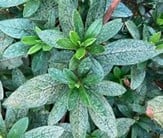
In the Upstate, most lace bugs emerge and begin feeding in late May or early June. But, if we don’t have a late frost, we may see them even earlier. Keep watch on the new, gorgeous emerging growth on your azaleas and Pieris. When it starts to show signs of mottling, it is time to exact revenge against Lace Bugs. Check again a month later to see if there are any other signs of Lace Bugs as here in the South, there is often a second generation.
AI says that Lace Bugs also feed on shrubs including Deciduous Azalea, Rhododendron, Mountain Laurel and Pyracantha. We’ve seen Lace Bug damage on leaves of the Deciduous Azalea and on Rhododendron types with azalea type leaves, but not on any others. Still, it’s good to check in the late spring just in case.
The mottling of evergreen azalea leaves is greatly misunderstood among gardeners and homeowners. They often believe their azaleas are “diseased,” when in fact it’s simply a pest, and one that can easily be controlled by pesticides. At Martin Garden Center, there are several methods that we use to control Lace Bug. In the past we used Permethrin. However, several years ago, we saw resistance to this chemical, so we stopped actively using it for Lace Bug control and instead use Acephate and Imidacloprid. For treatment, we spray these chemicals on the undersides of the azalea leaves after blooming had ceased, and when we begin seeing signs of Lace Bug damage on new growth. However, for the varieties of the Gumpo Azaleas which flower in June, we don’t recommend the use of Imidacloprid because the blooms are bee attractors and because Imidacloprid may affect the bees.
We do regularly check our Azaleas for signs of Lace Bugs later in the season, just in case we missed a few. You should too. Homeowners/gardeners with azaleas don’t have to tolerate ugly azaleas. They simply need to apply preventative spray when the pests (Lace Bugs) are vulnerable (late May/Early June).
Note that is should only take two years before your old, infested leaves are replaced by new growth without Lace Bug damage. This will also likely mean that you will no longer need to spray or your spray amount will be lessened unless, of course, your neighbor is an idiot and doesn’t spray their plants, and consequently their pest-ridden plants are constantly trying to contaminate your plants. Welcome to suburban and urban living!!!
Leaf Footed Bugs – Leaf Footed Bugs are bizarre looking bugs that look like they are covered in armor. They are also commonly confused with stink bugs except that their distinct large back legs look there is a leaf attached to it.
They like to feed on fruit and vegetable plants, and make no mistake, tomatoes are fruit and probably the biggest target plant that we hear complaints about. Leaf Footed Bugs also are attracted to squash, zucchini, melon, and sunflowers. And, while they don’t destroy the plants or the fruit/vegetable, their piercing/sucking mouthparts will leave unsightly blemishes and hardened spots and don’t nobody want hardened spots on their fruits and vegetables.
Leaf-footed bugs can occasionally be found on milkweed plants, although milkweed isn’t their primary target. These bugs are sap-suckers, and they may pierce the stems or seed pods of milkweed to feed. While milkweed contains toxic compounds (cardiac glycosides) that deter many insects, leaf-footed bugs have adapted to tolerate these chemicals.
Their presence on milkweed can sometimes interfere with the plant’s ability to produce seeds, which are crucial for supporting monarch butterflies and other pollinators. Ergo, Leaf Footed Bugs are definitely not our friends nor are they friends of the endangered species like monarch butterflies. Ergo, they are foes, and they must go.
The fully armored adult Leaf-Footed Bug is not easily eradicated by pesticides. Bonide’s Insecticidal Soap can be used for Nymphs. But for mature, armored bugs, try a knockdown such as Bonide’s Spinosad and then stomp on them for good measure. Note that adult Leaf Footed Bugs are easy to catch and remove from your plants for later stomping/squishing.
The nymphs of the Leaf Footed Bugs are easy to identify and to treat. They tend to be a coppery color with black dots on their abdomens, and they tend to gather in groups. And, when in their early nymph stages such as shown in the picture, they are easily eliminated. See the discussion under Squash Bugs below and follow the same approach.
Mealy Bugs – Mealy is indiscriminate. In fact, mealy is a hateful insidious little B$$@%#$ that hides in the nooks and crannies of plants where they are generally impossible to see or to reach by conventional spraying methods. But, although it is indiscriminate, it tends to congregate with its host plant and so insane infestations are often found … scary.
Mealy grows from egg to adult in 2 weeks and live up to 12 weeks. Females lay 500 eggs in their lifetime. The young mealybugs nymphs, referred to as crawlers, cannot be seen with the naked eye. They are quite mobile and crawl off to colonize other plants … even more scary.
When we find one, it means that nearby lurks others maybe in the thousands. Alcohol and water will kill those that you see but it’s the crawlers and the others, invisible to the naked eye, that make up the army of infestation, which means that after we find mealy on one plant, we need to spray that plant and the surrounding area, and we need to spray it thoroughly TWICE.
Remember, mealy is insidious and will crawl into nooks and crannies. We practice regular control spraying in our enclosed greenhouses, and this is a good preventative. When we find mealy, we immediately treat with alcohol and water. If 90% isopropyl alcohol, we go 50:50 with water. If 70% isopropyl alcohol, it’s more like 65% alcohol, 35% water. But this mixture can only kill the mealy we see. So, we follow up immediately with Acephate or Imidacloprid, both of which are systemic, and absorb into the plant to kill the mealy that we can’t see. These are the only over-the-counter chemicals that eradicate mealy.
In the production area and in the greenhouse, we try to spray Acephate every month during prime growing season. When we spray, we spray every inch … the walls, the floors, the tables, the drains, the plants, the trays, the wire … to ensure complete eradication. If we have an infestation, we spray again in one week just to be safe.
We have found mealy on nearly every plant in the greenhouse but some that we pay close attention to in the greenhouse are pilea, polka dot plant, ivy, creeping fig, crotons and fig trees. Outside, of course, heuchera, sage, and coleus are big favorites of mealy. But, since these are outside plants, after first frost, any mealy outside will be killed by the cold.
Be aware that mealy can and will overwinter here in the Upstate. They migrate underground, feeding on roots and even reproducing underground. This unique behavior allows them to endure harsh conditions by avoiding exposure to freezing temperatures. In colder zones where the ground freezes, mealy is not as likely to be capable of overwintering. In sum, mealy infestations can be common on trees such as crepe myrtle and magnolias, and the mealy bug can overwinter in the root zones of these trees. So, be prepared to continue any battles with mealy on your trees this spring that you hoped would have been solved by the winter freezes.
Mites – See Spider Mites.
Moles, Voles – Some gardeners want the mole/vole to go elsewhere. Some gardeners want the mole/vole to die. We don’t judge.
Voles, as you know, are the main munchers on root systems of ornamental plants. They can take out the tender roots of trees & bushes in a few days, and they absolutely love the root system of hosta.
We carry Vole/Mole repellants such as Bonide’s Vole Repellant RTS (the main ingredient is castor oil). We also carry Bonide MoleTox, which terminates moles and voles. Again, we don’t judge. We have tried the nuisance hi-frequency transmitter, but many said it didn’t work and had other unfortunate side effects, so we don’t carry it anymore.
Preventatively, you can plant your hosta in rock lined soil because voles don’t like to dig through rocks. It works.
Mosquitos – These little bloodsuckers are not just a nuisance, they can be deadly. Diseases such as Malaria and Dengue Fever, and virus such as the Zika Virus (which can cause birth defects) and the West Nile Virus (which can cause nuerological problems), can be transmitted by Mosquitos.
At Martin Garden Center, we carry Summit Mosquito Dunks and they are a cheap and effective solution to draw mosquitos away from humans. And guess what? At Martin Garden Center, we also use Summit Mosquito Dunks. We place them in our Greenhouse (2), Production (2), Back 40 (2), Cabbage Patch (3) and in our front parking lot, rear parking lot and beyond.
Yes, it is a pain in the toucas to have to replace them every month. But, people, THEY WORK. So, if you have mosquito problems, place dunk buckets at strategic locations on your property slightly AWAY from where the humans congregate. Then replace them monthly throughout the season. They are cheap, but they work far better than anything costly or harmful to the environment like those clouds of commercially available sprays that have all but eradicated lightning bugs.
We also carry Summit Mosquito Bits which can be added to pooling water located throughout your property. Way to think it through Summit!!!
Finally, we also sell several plants that repel mosquitoes including citronelle, lemon grass and lemon balm. Our customers buy them in droves. But, while they will repel mosquitoes, they do not “eliminate” them so consider Mosquito Dunks and Bits for a better outdoor experience.
Nematodes
We will get back to this when we have time
Rabbits – See Chipmunks.
Squirrels – See Chipmunks.
Scale – Scale, which is closely related to mealy, is a difficult to control pest and is much more hardy than mealy. Scale comes in many colors, from white to brown to black, and hard to find green. If often overwinters on leaves of evergreen trees, as well as branches and trunks of trees. In the Upstate, Magnolia trees and native Chionanthus virginicus (aka, Grancy Graybeard) have been commonly found to have scale issues. Euonymus bushes are attractors of scale and may require treatment every 5 of so years. Also, some of our ornamental trees have been found with issues from time to time.
Use of Horticultural Oil as a preventative will help. However, for severe infestations, we do rely on Imidacloprid and our old friend Acephate. This is because as systemics, these chemicals absorb into the plant and cure the plant from the inside out. As previously discussed, anytime we use a Neonicotinoid such as Imidacloprid, we always take care to use it during non-blooming periods so as to protect our bee population. And so should you.
Slugs & Snails – Grab onto a slug once and you’ll never forget the texture. Slimy and moist and ugh!!! At Martin Garden Center, we find them on the bottoms of pots and under trays all of the time (they love moist dark areas) and they tend to feed at night when it’s cool.
Slugs are actually beneficial in that they eat dead and decaying matter. They also feed on our beloved plants. They LOVE hosta. Spring veggies and fall veggies are also huge favorites and both slugs and snails love lettuce.
When trying to determine if slugs have been the culprit in plant destruction, look for shiny slime trails and holes in target plants.
Slugs are relatively easy to control. You can squish them by hand if you can deal with the texture or just take some snips and knock them off into a bag or bucket and squish them later. Night raids are likely to net more than daytime raids
You can buy iron phosphate granules that will kill slugs and snails. We carry Bonide Slug Magic. And, of course, there is the old beer vat method. Slugs and snails are attracted to the smell of beer. Simply bury a bowl filled with beer at ground level, the let the slugs and snails crawl in and die happy.
To prevent slugs and snails from getting to your plants, you can elevate your plants off the ground and plant them in containers. Diatomaceous Earth placed as a circle around your in-ground plants is also a great way to prevent all crawling bugs and slime sliding slugs and snails from getting to your plants. At Martin Garden Center, we carry Bonide’s Diatomaceous Earth. Note that you will need to add more after heavy rainfalls etc.
Note that the one difference between snails and slugs is that snails tend to remain on plants in the full daylight. This makes snails easy to bait and catch. Try leaving out a small pile of cabbage leaves in the fall or melon rinds in the spring, and the next morning, remove the snails that are still enjoying the bait.
Oftentimes, people confuse scale on plants with snails. See our discussion under Scale for more information.
Snakes – The majority of the human population have an unrealistic fear of snakes which is unfortunate given that snakes help keep our rodent, insect and other pest population under control.
Most snakes in the upstate tend to be non-venomous. There are 3-4 varieties of venomous snakes in the Upstate and by far the most common is the copperhead, followed by the Timber Rattlesnake and the Cottonmouth. All three have the triangular head common with many venomous snakes. The fourth venomous snake, the coral snake, is very rare in the Upstate and does not have a triangular head. The non-venomous kingsnake is often mistaken for the coral snake.
When snakes are a nuisance, snake deterrent products can be used. Typically, these contain naphthalene and Sulphur. These ingredients work together to create an unpleasant environment for snakes, encouraging them to move away from treated areas. However, the effectiveness of these products can vary, and they should be used with caution, as naphthalene is toxic to humans and pets if ingested or inhaled in large quantities. At Martin Garden Center, we carry Bonide’s Snake Stopper.
Spider Mites – Spider Mites are probably the worst of the indiscriminate pests. They will go for anything and everything. They prefer roses, sun king aralia, ivy, elephant ears (colocasia) and alocasia, butterfly bushes, rosemary and dahlias. In shrubs, we have found them on fatsia, pieris, boxwoods, beautyberry, and spirea. In the greenhouse, they tend to gravitate toward alocasia, ivy, citrus, diffenbachia, cast iron, nephthytis, calathea, palms, peace lilies, dracaena, aglaonema, philodendron, hibiscus, mandevilla & ficus. Did we miss anything?
Spider mites are difficult to see with the naked eye so to identify them, you unfortunately are looking for mite damage. Look for mottled or stippled leaf surfaces. Look for webbing underneath particularly along the vein … a fine mist makes webbing more apparent. To test for Spider Mites, you can conduct a “Mite Test,” by shaking foliage believed to be infected with mites over a plain white piece of paper. Intently watch any black spots that fall to the white sheets to see if they move rapidly off the page. You should watch for about 30 or more seconds for the movement given that the Spider Mites are shaken up from the fall.
Spider Mites, being super small and super lightweight, can move around very quickly. They are light enough to become wind-born, and they can catch a ride on you or your pet. From egg to larvae to nymph to adult can take as little as 5 days under ideal conditions but ranges from 5-20 days. The average life span of Spider Mites is 3-4 weeks with hundreds of mite eggs produced.
Mites thrive in dry warm conditions and dislike water so splashing under leaves, where mites reside, is a smart practice. At Martin Garden Center, the primary over-the-counter pesticide to eradicate spider mites is Neem Oil. We carry lots of different types of Neem Oil. We recommend Ferti-lome’s Triple Action which contains Neem Oil with Pyrethrins. This can be combined with Bonide’s Insecticidal Soap for a triple whammy.
Take great care when using products with Neem Oil because, above 90 degrees, Neem Oil can cause burning. In the South, temperatures may rise to 90 degrees and remain that way for months. So, if you have mite issues, treat your plants in the evening and then rinse your plants thoroughly the next morning. Note that treating infestations again, 7 days apart, will be your best chance at eradication.
Squash Vine Borer Bugs – The squash vine borer is the larvae resulting from the moth known as Melittia cucurbitae. This moth lays eggs at the base of squash plants, which hatch into larvae that bore into the stems. Once boring begins, the squash plant will wilt and often will die. And, once squash borers have found your squash and zucchini, they will be repeat visitors because the moth’s pupa will overwinter in cocoons in the soil and mulch nearby.
Squash vine borers can be a gardener’s nemesis, but there are ways to prevent and eradicate them … but it takes a lot more effort than ordinary pests. So, prepare for the daily battle.
First and foremost, you have to be checking daily. In the upstate, the Melittia cucurbitae moth is often found early- to mid-May feeding on flowers. If you see it, use Spinosad as a knockdown and stomp on it. Spinosad can be found in Bonide’s Jack’s Dead Bug Brew RTU which you can find at Martin Garden Center.
When it is mature enough to reproduce, the Melittia cucurbitae lays its eggs near the base of the squash plant so when the larvae are active, they will bore in at the base of the vine. Consider placing yellow sticky pads at the base of your squash and zucchini to draw the moth. We sell these sticky sheets at Martin Garden Center. Also, look for the eggs on the underside of your squash leaves and remove the leaves to the trash if eggs are detected. Applying Neem Oil to the tops and undersides of all leaves may deter the Squash Borer Moth from laying eggs on the plant. But, you have to apply Neem Oil regularly from early-May till the temperature rises above 90F. Remember, if the temperature rises above 90F, you can no longer apply Neem Oil or your plants will burn. At Martin Garden Center, we sell numerous brands of Neem Oil.
One preventive technique is wrapping the lowers stems of the vine with aluminum foil or nylon stockings. Have not tried this yet but it makes sense. Another approach is when finding borer holes, inject BT using a syringe (a 3cc syringe should be adequate) into the holes and cover the holes with tape. The BT will kill the larvae hopefully before it can damage the vine permanently. And, with the larvae dead, these are a few less moths to contend with in the following year.
We also recommend regularly and liberally applying BT dust (Bonide’s Dipel Dust) on the base of the vines. If the pupae ingest only a small amount of BT when boring in, it will kill them. We recommend using a flour sifter to apply Dipel Dust. After a rainfall event, apply more Dipel Dust, as it is inexpensive. Some other suggestions … try applying black pepper, ashes, and Diatomaceous Earth around the plant to keep the creepy crawlies away.
We are not a fan of netting because it can trap beneficial insects and pollinators inside, so avoid netting. PLEASE.
Of course, crop rotation is smart. If you’ve had borer problems in previous years, don’t plant your squash and zucchini in the same please because the Mellitia cucurbitae‘s pupae are overwintering in cocoons in the soil and mulch nearby. Note that because the pupae overwinter nearby, tilling your soil well at the end of the growing season and before the beginning of the growing season may slice and dice some but unfortunately not all of the pupae in the soil waiting to destroy your spring crop.
Planting companion plants that deter Squash Borer Bugs or that attract predators of Squash Borer Bugs is another suggestion. Here is a good list or we think it is a good list:
Adult Squash Bugs are commonly confused with Stink Bugs because they look the same … a flat armored body that releases a foul odor when disturbed. A brown hue is common as noted in the picture above, but most are dull grey/brown … like a stinkbug. The adults can almost be black.
- Dill, Parsley, Lavender and Radish blooms attract damsel bugs (Nabis sp.), that is a predator of the Borer Squash Moth.
- Carrots, Dill & Parsley attract Feather-legged fly (Trichopoda pennipes) which lays eggs on the Borer Squash moth and the eggs hatch into borers which bore into the Mellitia cucurbitae … a fitting end … though not quickly enough.
- Plant Blue Hubbarb Squash early as use as a sacrificial plant for the borers. Then, throw it away in the trash when infected (or inject with BT).
Finally, if any of your vines do succumb to the borers, dispose of them in the trash. Don’t place them in your compost as this just gives further opportunities for Squash Borer propagation. In conclusion, yes, there are a lot of steps to take, but the Squash Borer Bug is one tough bug to eradicate. So, if you want fresh squash and zucchini, then commit to the battle.
Squash Beetles (aka Squash Bugs) – As if the cucurbit family of plants didn’t have enough problems with the Mellitia cucurbitae squash vine borer moth and her boring larvae, there have to be Squash Beetles. There are a number of different species that share the name “Squash Bug.” For example, the squash lady beetle (Epilachna borealis) will feed on squash leaves as does the more commonly found squash bug, Anasa tristis. And, the Leaf Footed Bug is also often referred to incorrectly as a squash bug. And, since they are controlled/eradicated in the same way, we won’t fault this incorrect conclusion.
This conversation focusses on the Anasa tristis Squash Bug, as it is commonly the problem Squash Bug in the Upstate. Luckily, while this is a problematic bug to eradicate as an adult, it is relatively easy to identify, control and eradicate in the egg and nymph stage. So let’s begin.
The Anasa tristis squash bugs use their piercing mouthparts to suck sap directly from the leaves, stems, and even fruits or cucurbit vegetables, mainly squash, zucchini and pumpkins. This feeding process damages plant tissues, leading to wilting and reduced plant vigor, and also to reduced yields.
The Squash Bugs begin as eggs and then undergo complete metamorphosis as they grow to an adult. Unlike many bugs, they don’t have a pupal stage involving a cocoon. Instead, they progress from eggs to nymphs. There are 5 metamorphic stages or “instars” as the squash nymphs progress from newborns to adults and by the 5th instar, the nymphs have developed armor and developed wing pads and are as difficult to kill as the adults.
Each instar involves molting, where the insect sheds its exoskeleton to grow larger. First Instar growth involves tiny nymphs with pale green abdomens and reddish heads, legs, and long antennae. White colors are also common. As they age, they turn to light gray and darker dull gray/brown. Throughout the Second to Fifth Instars, the nymphs grow larger and become more impenetrable with each molt. By the fifth instar, they have developed wing pads and start resembling adults. At the adult Stage, they are fully armored and fully developed adults with wings and a dark brown or dark gray almost black body. From first instar to adulthood takes several (4-6) weeks.
The key is to identify the eggs and the nymphs in the first and second instars to better eradicate these pests. This requires almost daily evaluation. First, with eggs, they tend to be arranged in compact groups of 10-20 on the underside of squash leaves. Closely examine each leaf for eggs and do so regularly. Because one day, there may be no eggs, and 2-3 days later, there are 20.
Note that the same coppery colored eggs of the Squash Bugs are almost identical to the eggs for the Leaf Footed Bug. Who cares which bug it is as both bugs must go. Gently remove the eggs using the sticky side of masking tape, duct tape or electrical tape. They can also be gently (and slowly) scraped off (some suggest a butter knife). Try not to mangle the leaves of the cucurbit plant but if you do, you can always remove the leaf entirely.
Once hatched, the nymphs tend to congregate in groups at all stages. The green nymphs pictured above still have soft bodies and thus are still susceptible to spraying with fatty soaps such as Bonide’s Insecticidal Soap or Bonide’s Captain Jacks Spinosad Soap. Stage 2 nymphs may be a white to light gray color. Stage 3 nymphs have soft gray bodies are still susceptible to fatty soaps. At stages 2 & 3, they are still congregating but are more likely to make a run for it when they see you. You can either spray these nymphs with insecticidal soap or you can try to knock them into a 5-gallon bucket filled with soapy water with a little salt to kill them. Even the late-stage nymphs and the adults are susceptible to a fatty salt dunk if allowed to soak and/or drown.
Some additional suggestions. First, elevate your Squash and Zucchini plant growth. Provide a rope, trellis, or cattle panel to allow the plant to grow upwards rather than remain on the ground. Secure your plant with flexible tape or soft ties, not wire. Martin Garden Center offers flexible tape in multiple lengths and width, as well as soft plant ties. We also offer wire but don’t use it to tie a vine.
Keeping cucurbit plants off the ground serves two purposes. One, this helps to prevent powdery mildew from reaching your plant leaves (helps but doesn’t always succeed … see the discussion of powdery mildew later in this summary). Second, it allows you to use Diatomaceous Earth as a barrier around your plants. Diatomaceous Earth, when applied around the base of a plant, keeps the creepy crawly bugs away from your plants. And, although Adult Squash Bugs can fly, most of the time, they just crawl, and the nymphs have to crawl. Ergo, the Diatoms in Bonide’s Diatomaceous Earth will help to slice their exoskeleton into little exo pieces. Amen!
Second, set a trap for those nasty bugs. Use a small shingle or a thin piece of cardboard or plywood and lay it on the ground nearby your squash plants. Cover it with newspaper. In the morning, you will find Squash Bugs under the newspaper and under the shingle/cardboard/plywood. Stomp them all. Then repeat in another place with another non-executioner piece of shingle, cardboard or plywood plus newspaper. Killing bugs … now that’s a gardener’s game that will never get old!!!
Thrip – Like Spider Mites, Thrip is indiscriminate. It will go for any plant anytime anywhere. For many plants, thrip has no effect on them. For some plants, it causes unsightly aesthetic damage. For some plants, it is a killer. Specifically, thrip-vectored viruses such as INSV (Impatiens Necrotic Spot Virus) are most deadly to lobelia. If you have problems with lobelia dying “without reason” at your home, it is probably because you have thrip infected with INSV that overwinter in your soil and emerge every spring to infest your plants and kill your lobelia. And, until you get control of the thrip in your yard, your lobelia will continue to die so don’t buy lobelia until you’ve solved your pest problem.
INSV also kills impatiens, peppers, tomatoes, begonias, nemesia, gloxinia, ranunculus, torenia, and zinnia but to date, we have not seen INSV affecting these plants at Martin Garden Center. We have had lobelia losses. And, we’ve tried all sorts of methods to treat and prevent. But, once a lobelia plant is infected with INSV, we have to remove it else the death sentence will spread to the next lobelia. Again, Thrip are extremely difficult to eradicate. So, when we raise lobelia, we take great measures to keep it clean and Thrip free.
Thrip are non-discriminate. They are often found on host plants that are unaffected and then transfer to nearby plants. Thrip can fly … but not far and not very well, which is why thrip infestations tend to go from one plant to the next nearby plant. And, it is also why sticky traps work, particularly yellow sticky traps, because Thrip seem to be most attracted to yellow and white colors and because they aren’t good flyers anyway so end up splat on the sticky card.
Thrip damage on plants takes on a splotchy tan and white/gray discoloration of foliage, plus twisted leaves and tan/brown edges of leaves are suggestive of Thrip. We can check for Thrip by performing the mite test. Place white paper beneath a plant and shake the branches above the paper. Debris will fall off the plant onto the paper. Wait 30 seconds and watch for slender brown, black and yellow Thrip to move across the paper to confirm your bug identification.
Thrip are very attracted to several plants including rosemary, verbena, calibrachoa, marigolds and peppers. Inexpensive yellow and white Marigolds, for example, are often used in gardens as Thrip attractors. Cuban Oregano is also a big Thrip attractor. These can be placed in front of gardens to lure Thrip away from vegetables and other valuable plants.
At Martin Garden Center, we tend to see aesthetic damage to verbena and calibrachoa. This requires us to treat the plant to eradicate the Thrip, and then to cut back the damaged foliage and flowers, which then must regrow before it is saleable. Consequently, we have a preventative spray program for Thrip, and one of the best pesticides to use is Spinosad. We sell two versions of Spinosad (both organic) at Martin Garden Center, Bonide’s Captain Jacks Dead Bug and Bonide’s Spinosad Soap and both are great for eradicating Thrip.
White fly – To be developed as time permits.
Fungicides
Fungicides are vital in gardening for preventing and controlling fungal diseases that can devastate plants and reduce yields. These chemicals work by inhibiting the growth and reproduction of fungi, protecting plants from infections such as powdery mildew, rust, blight, and leaf spot. Fungal diseases can spread rapidly, particularly in warm, moist conditions, and can cause significant damage to both ornamental and edible plants.
The effective use of fungicides in gardening involves understanding the specific fungal diseases affecting plants and selecting the appropriate product. For example, powdery mildew, a common fungal disease that creates a white, powdery coating on leaves and stems, can be controlled with fungicides specifically labeled for this purpose. Fungicides can also be applied as preventive measures before any signs of disease appear, particularly in environments prone to high humidity and poor air circulation, which favor fungal growth. Alternatively, curative fungicides can be used to treat plants already showing symptoms of infection.
Our Selection of Fungicides
Martin Garden Center carries the following contact and systemic Fungicides:
- Copper Fungicide – We carry Bonide brand Captain Jack’s Copper Fungicide in 32 oz Ready-To-Use (RTU), 32 oz Ready-To-Spray (RTS) and 16 oz Concentrate. This is a contact fungicide that is preventative. To be effective, it must coat all parts of the plant. This product is organic.
- Neem Oil is a constituent in multiple combination chemicals in RTU, RTS and Concentrates. The most popular is Ferti-lome Triple Action which contains Pyrethrins and Neem Oil and is available in 32 oz RTU, 32 oz RTS, and 8, 16, and 32 oz Concentrate. Neem Oil is a contact fungicide and is both curative and preventive. To be effective, it must coat all parts of the plant. Note that Neem Oil will be absorbed into the plant but is not considered systemic for fungicidal applications. Using Neem Oil when temperatures exceed 90F will cause burning. So, if you must use Neem or other oils in the hotter months, spray in the evening after temperatures drop below 90F and then rinse your plants well the next morning to remove oil residue. This product is organic.
- Propiconazole (active ingredient in Infuse) – We carry Bonide’s Infuse in 32 oz Ready-To-Use (RTU), 32 oz Ready-To-Spray (RTS) and 16 oz Concentrate. Infuse is a systemic fungicide that is mainly preventative but does have some curative properties. Its residual may extend up to 4 weeks (depending on rain). This product is NOT organic.
- Chlorothalonil (active ingredient in Fung-onil) – We carry Bonide’s Fung-onil in RTU 32 oz and Concentrate 32 oz. Fung-onil is a contact fungicide that is curative and preventative. This product is NOT organic but can be used on fruits and vegetables.
- Wettable Sulfur – We carry Hi-Yield Wettable Sulfur in 4 lb bags. This is a contact fungicide that is This produce is NOT organic but can be used on fruits and vegetables.
These fungicides are used to cure and prevent fungal diseases such as those summarized alphabetically in the paragraphs that follow.
Fungal Diseases Identification, Prevention and Treatment
Black Spot – Black spot, or leaf spot, is a common fungal problem that leads to discoloration of the foliage of certain plants. Hydrangeas and roses are the most commonly susceptible plants. Black spot is indiscriminate, however, so other nearby plants, if susceptible, can become discolored if the fungal spores are nearby.
Leaf spot is an aesthetic problem, not a deadly problem. Once the leaves are spotted, there is no way to remove the spotting from the leaf unless you remove every leaf or cut back your plant … which is just plain silly since most affected plants are deciduous and lose their leaves at first frost anyway. Instead, you must prevent leaf spot.
Preventive spraying is the only way to prevent leaf spot if fungal spores are present in your garden (save removing all your mulch and disposing of it and replacing it with new, fungal-free mulch (good luck with that)). Organic solutions such as Neem Oil and Captain Jack’s Copper Fungicide can be applied before or immediately after noticing leaf spot. Regular applications of fungal preventive sprays will prevent further spread of leaf spot and instructions suggest weekly spraying.
At Martin Garden Center, we don’t have time for all that, so we use a synthetic solution which has a residual lasting longer than one week. Every 4 weeks beginning in April, we spray our hydrangeas for black spot with Propiconazole (the active ingredient in Bonide Infuse). We’ve done this since 2016 ish, and it has been highly successful in preventing black spot. As such, we likely no longer have active fungal spores in our Shade House in which our Hydrangea are located, so maybe soon we’ll be brave and stop treatment … or maybe we won’t. Go figure!
We LUV propicanazole, the active ingredient in Bonide’ Infuse and we highly recommend buying Bonide’s Infuse Ready to Spray (as pictured). One bottle will cover hundreds of hydrangeas, so it is well worth the cost for most homeowners as it will last for years (unless you have hundreds of hydrangeas). See the summary of the available Infuse containers we carry under Our Selection of Fungicides.
Blight (Fruit Trees) – We don’t carry fruit trees for reasons including blight. So, you are on your own in determining causes and solutions.
Blight (Tomatoes) – Years ago, we knew less about Tomato Blight than we do now. We used to tell customers if they suffered blight, they could never grow Tomatoes again in that spot. Now, we know more.
Tomato Blight is caused primarily by two types of fungi: Alternaria solani (early blight) and Phytophthora infestans (late blight). Early blight begins with dark spots on yellowing foliage. Brown concentric circles on the spots are a tell-tale sign of blight. Left unchecked early blight may continue and expand to dark lesions on branches and stems. The fruit on the weakened plant may also have lesions but early blight rarely extends to the fruit. Instead, lesions on the stems will lead to lessened yield because nutrients can’t get to the fruit.
Late blight usually occurs when temperatures cool and dew is more likely to form, meaning at daytime temperatures in the 70-77F range and nighttime temperatures in the 50F range. The late blight signals are very similar to early blight but the foliage dies quickly and the fruit rots quickly. Watery tomato spots on green fruit are common. Often there is white fuzzy fungus on stems and fruit.
Late blight caused by the Phytophthora infestans (loose translation is “Plant Destroyer”) is far more problematic and difficult to treat. Once cankers appear on stems, the tomato vine is unlikely to produce further fruit. Further, once fruit become infected, they will rot very quickly. A growing movement within the gardening world suggests that trying to treat late blight is meritless and only helps spread blight to neighboring gardens.
Tomato blight thrives in humid conditions and can spread rapidly, especially in crowded gardens or fields with poor air circulation and poor sanitation. Management of tomato blight involves using resistant tomato varieties, practicing crop rotation, ensuring proper spacing for adequate airflow, removing branches with potential fungal issues, and applying fungicides as necessary.
Early detection and prompt action are crucial in preventing the spread of this devastating disease. Specifically, upon observing discoloration of foliage in early blight, remove leaves and dispose of them (don’t place them in the compost, place them in the trash). Thin other non-bearing leaves to promote air circulation. Remove debris from the area. Consider spraying with Bonide’s Copper Fungicide or Bonide’s Fung-onil to prevent any further outbreaks.
Blossom End Rot – Can’t believe that there are gardeners out there who don’t know these two important facts. First, our native clay soil, Piedmont Ultisols, has lots of minerals. It is chock full of iron hence the red color of the clay, but it is completely devoid of the mineral calcium. So, if you are going to have a successful garden using our local compact clay soil, you need to break up the compact red clay using an infusion of organics. We suggest Mushroom Compost and Soil Conditioner also sold at Martin Garden Center.
Second, the majority of the vegetables and flowering plants that we plant here in the upstate are calcium needy. So, to be successful as a gardener, YOU MUST ADD CALCIUM to your soil. Otherwise, you will have blossom end rot and a whole host of other problems.
Blossom end rot doesn’t just affect tomatoes. It also affects peppers, eggplant, melons, squash and zucchini, and a whole host of other vegetables. And, when it comes to flowering plants, which are also calcium needy, you also need calcium to be infused in your soil.
You can get calcium free by using eggshells, clam shells and oyster shells from the food you eat. Otherwise, you have to add calcium. Our Martin Garden Center TOP RECOMMENDATION is Espoma’s Tomato Tone because it is organic and because it has the highest percentage calcium of any of the Espoma Tone products. We’ve tried other products which have had higher percentages of calcium, and they did not work as well as Tomato Tone. Ergo, if you have had blossom end rot, buy Tomato Tone. End of discussion!
Botrytis – Botrytis, commonly called gray mold, is a common fungal disease caused by the fungus Botrytis cinerea. This pathogen thrives in cool, humid conditions, particularly when moisture is present on plant surfaces. It spreads rapidly in environments with high humidity, poor air circulation, and fluctuating temperatures. To minimize Botrytis infections, it’s essential to improve airflow around plants, reduce excess moisture, and remove any decaying plant material.
Botrytis, if left unchecked, can be a killer. The fungus enters through wounds or weakened areas, then spreads rapidly, causing soft, mushy decay on leaves, stems, flowers, and fruits. As the infection progresses, Botrytis blocks water and nutrient flow, leading to wilting, browning, and eventual plant death.
Prevention is key. Consistent watering which allows the upper top 1″ of soil to dry between waterings is crucial. Also, proper spacing to allow airflow is very important. Finally, removing the under canopy of decaying plant materials is also important. By addressing these issues, Botrytis may be eradicated without having to take extreme measures.
Once Botrytis takes hold, blackening of the foliage particularly at the base of the plant will spread if corrective action is not taken. In environments where high humidity and moisture cannot be controlled (e.g., long term rainfall events), it is often necessary to introduce fungicides. At Martin Garden Center, we prefer the curative and preventative properties of Chlorothalonil, which is the active ingredient in Bonide’s Fung-onil.
Note that Fung-onil does indicate that it can be used on fruits and vegetables but educate yourself before doing so. So, removing contaminated foliage and using an organic preventative such as Bonide’s Copper Fungicide may be your better choice for edibles. See the discussion under Our Selection of Fungicides to determine available Copper Fungicide and Fung-onil offerings at Martin Garden Center.
Downy Mildew – Downy Mildew often looks very similar to the Powdery Mildew nuisance discussed in detail below. But even though they look alike and are often confused for one another, the big difference is that Powdery Mildew is a nuisance and Downy Mildew is a killer for many plants.
So what plants are we talking about? The most recent and most disconcerting is basil. Several years ago, Basil Downy Mildew made its way into the Upstate and crops began to fail. The Basil Downy Mildew (caused by Peronospora belbahrii) began with grayish undersides of leaves followed by immediate yellowing of leaves, followed by defoliation and death.
Basil growers immediately began scaling back their Basil production and growing only varieties showing resistance to Downy Mildew. And, while this has worked reasonably well with keeping our basil plants healthy, customers have noted the limited variety. Our only recourse is to HIGHLY RECOMMEND to our customers that they start growing their own basil varieties, and to this end, we now carry a lot of basil varieties in seed packets.
Another plant that has succumbed to their own form of Downy Mildew (caused by is Plasmopara obducens) is the shade impatien (impatiens walleriana). We used to sell thousands of shade impatiens every year, but we can no longer stock shade impatiens flats at Martin Garden Center because if we do, they will become infected and catastrophically fail. Instead of shade impatiens, we now offer the New Guineau Impatiens and SunPatiens that are not susceptible to Downy Mildew.
Many fruits and vegetables are also susceptible to Downy Mildew but we don’t hear as much about it because the variety of Downy Mildew is not a killer or because growers that supply our plants have selected resistant strains. Some of the affected plants include Grapes (Vitis vinifera), Lettuce (Lactuca sativa), Cucumbers (Cucumis sativus), Broccoli (Brassica oleracea var. italica), Spinach (Spinacia oleracea), Roses (Rosa spp.), Sunflowers (Helianthus annuus), Sage (Salvia spp.), Peas (Pisum sativum), Onions (Allium cepa), Zinnias (Zinnia spp.), Pumpkins (Cucurbita pepo), and Melons (Cucumis melo) according to AI.
Prevention remains the best mode of defense against Downy Mildew. Particularly, growing resistant varieties, practicing crop rotation, ensuring proper spacing for adequate airflow, removing branches (and sometimes plants) with fungal issues, cleaning plants and removing debris from around plants, watering at the base of plants, and applying fungicides as necessary. In the case of Downy Mildew, Bonide’s Copper Fungicide is an effective preventative organic product. Also, Bonide’s Fung-onil is both curative and preventative. See the discussion above under Our Selection of Fungicides for more information about the Fungicide containers offered at Martin Garden Center.
Leaf Spot – See the discussion under Black Spot.
Powdery Mildew – Love Zinnias and the myriad of cut flowers that they offer profusely all season long. BUT … if you have zinnias, you will have powdery mildew … unless you spray. The good part is this – the flowers don’t get powdery mildew, just the foliage, so you can still harvest the flowers without the ugly. The bad part is the foliage is plain ugly … unless you spray.
Powdery Mildew is indiscriminate and can affect any nearby plant. However, some plants are more susceptible than others. So here is a rundown of the most susceptible plants to powdery mildew according to Martin Garden Center as supplemented by AI … Roses, Cucurbit Veggies (Squash, Zucchini, Cucumber and Melon), Beans and Tomatoes, and ornamentals especially, Zinnia, Dahlia, Hydrangea, Gerbera Daisy, Coreopsis, Monarda and Upright Phlox. And don’t forget poor Peonies. And, as fall comes on, Black Eyed Susan (Rudbeckia), Echinacea (Coneflower), and Herb Sage are also problematic at Martin Garden Center.
Luckily, with treatment, you can send Powdery Mildew into remission (unlike black spot that once formed is here to stay). Furthermore, for the most part, powdery mildew is not deadly but for Squash, Zucchini and Peony, it often does serious damage to the plant. So, what to do? First, for food crops, you would likely want to use an organic spray to prevent powdery mildew. That means either Copper Fungicide, Wettable Sulfur, or Neem Oil. Copper Fungicide is much more effective, by the way, for preventing fungus, but Neem Oil is a Miticide, Insecticide and Fungicide rolled into one. However, it cannot be sprayed when temperatures exceed 90F or you risk burning your plants. Wettable Sulfur is another viable solution for food products. Dismiss any fears that the Sulfur will negatively affect the pH because our indigenous clay soils have a great buffering capacity, and the amount of sulfur used will have little to no effect on the soil. With Sulfur, you must ensure coverage on all parts of the plant … the stems, fruit and vegetables, flowers, leaves (tops and bottoms) with application also to the soil. Also, don’t apply sulfur within 2 weeks of horticultural oils such as Neem Oil.
If you had powdery mildew last year, then you should have been preventatively spraying beginning in April (in the Upstate). You have to be proactive so that your problem does not spiral out of control. So now you know to begin spraying next year before the problem arises. Start in late April/early May. For your fruits and vegetables that develop powdery mildew, Copper Fungicide is your best option because of its ease and less restrictions. While it is only preventative, it can be used to stop any additional powdery mildew, and any existing contaminated foliage can be removed. See the discussion above of Our Selection of Fungicides to determine available Copper Fungicide, Wettable Sulfur, and Neem Oil offerings at Martin Garden Center.
For non-edible plants, your best bet is Chlorothalonil (the active ingredient in Bonide’s Fung-onil). Chlorothalonil is curative and preventive, meaning that it will cure the plant of powdery mildew. Note that Fung-onil does indicate that it can be used on fruits and vegetables but educate yourself before doing so. Remember, powdery mildew is a nuisance, not a killer. So, removing contaminated foliage and using an organic preventative may be your better choice for edibles. See the discussion under Our Selection of Fungicides to determine available Fung-onil offerings at Martin Garden Center.
Finally, preventive-wise for powdery mildew, Martin Garden Center’s go-to for non-edible plants is Propiconazole (the active ingredient of Bonide’s Infuse). See the discussion under Our Selection of Fungicides to determine available Bonide Infuse offerings at Martin Garden Center.
Rust – Rust is naturally occurring in our environment. Many of the carriers of rust are completely unaffected by it. For others, Rust is a killer.
At Martin Garden Center, we have pine trees which are natural rust carriers. The rust has no effect on the pine trees but any plant on our property, unless under cover, is exposed to rust. So, while we carry rust-susceptible plants, we have to take certain precautions while they are at Martin Garden Center.
- Roses – We don’t grow Roses at Martin Garden Center but we highly recommend preventatively spraying Roses beginning in early March with our favorite preventative Infuse and would suggest this for all Roses planted near rust carriers (e.g., pine trees).
- Hollyhock – Each spring, we carry Hollyhock plants in, but they are contained in an enclosed environment in our plastic covered Sun House. The Hollyhock plants are fronted with a big “Buyer Beware” sign that explains the rust issue. Although Martin Garden Center has rust carriers, not every home has naturally occurring rust. We want our customers to have the opportunity to plant these amazing beauties, but we want to fully disclose the folly of planting Hollyhock near rust carriers (e.g., pine trees) as it is a death sentence.
- Snapdragon – Yes, believe it or not, Snaps are susceptible to rust. Consequently, we carry rust resistant snaps that have not failed us yet. Buy with confidence … for now.
- Blackberries and Raspberries – Scary times … there is a new orange rust on Blackberries (and sometimes Raspberries) that is deadly. There also is another orange rust that is problematic but not deadly. How to tell the difference?
The non-deadly Puccinia comari orange rust pictured above have more concentrated pustules and appear very early in the growing season. It looks like orange powder. The deadly Gymnoconia nitens rust have larger Pustules. There were no public pictures available so here is a link to the only good picture available: WNC Vegetable and Small Fruits News: Blackberry Rusts (wncveggies.blogspot.com)
The deadly Orange Rust (Gymnoconia nitens) postules are obviously much larger. And, the postules cause yellowing at the edges of the leaves. The leaves become distorted and pale green or yellow, and the plant’s overall vigor declines and it fails to bear fruit. Once infected, the blackberry remains a carrier of the disease for life, infecting nearby plants. In sum, if you discover you have a Gymnoconia nitens infested plant, remove it and dispose of it to keep it from infecting other rubus plants.
Then, there is Yellow Rust (Phragmidium rubi-idaei). Yellow rust appears as small, bright yellow pustules on the undersides of leaves. As the disease progresses, the pustules darken, and the leaves turn yellow and fall off prematurely. Yellow rust causes defoliation, reducing the plant’s ability to photosynthesize and weakening the plant over time. Severe infections can lead to reduced fruit production and overall plant health. But it’s not a killer and can be treated.
At Martin Garden Center, we do preventatively spray our blackberry and raspberry plants with Chlorothalonil (the active ingredient in Bonide Fung-onil) and with Copper Fungicide (Bonide’s Copper Fungicide). - Grains & Fruit Trees – We don’t carry these for so many reasons, so you are on your own in diagnosing.
For rust, preventatively, organic Copper Fungicide can be used as can Infuse (not for use on fruits and vegetables). Fung-onil and Wettable Sulfur both provide curative and preventative treatment, and both can be used on edibles even if they are not organic.
Rose Rosette Disease – Won’t spend a lot of time on Rose Rosette Disease because Martin Garden Center stopped carrying Roses over a decade ago because Rose Rosette Disease (RRD) becoming rampant in the Southeast. According to AI, it began in Manitoba, Canada, ergo please feel free to launch into a version of the song, “Blame it on Canada.”
With Rose Rosette Disease, also called Witch’s Broom, the rose growth becomes stunted. Thorns erupt everywhere. The new foliage is bright pink to red and deformed/twisted. Tightly packed shoots cluster at the tips of branches, which some man somewhere thought looked like a broom, hence the alternative name Witch’s Broom.
All joking aside, RRD is a lethal virus that decimates roses. It is spread by a microscopic eriophyid mite Phyllocoptes fructiphilus. RRD has spread across 33 states in North America and there is no cure. There are no roses known to be 100% resistant to RRD (hence our decision to stop carrying roses). Some roses are believed to be resistant, but no rose is completely immune.
Since the disease is spread by mites, practicing preventive spraying for mites may be the only way to prevent infection. Preventative spraying is a lot of work, but it is worth it to prevent the spread of RDD, as it is completely devastating for our customers to lose their roses to this insatiable and incurable disease. Please see our Mite summary to learn about spraying for Mites.
Martin Garden Center will start carrying roses again when a cure is found. Given the amazing bounds in technology over the last several years thanks in large part to AI, we are hopeful to see roses again soon at MGC. Fingers crossed!
Hellebore Black Death – Helleborus net necrosis virus (HeNNV), also known as Hellebore Black Death, is a deadly viral disease that causes black streaks and blotches on hellebore leaves, stems, and flowers. HeNNV does not affect all hellebore variety, just Hellebore orientalis which are the common old-fashioned types. Most home gardens aren’t affected but many growers lost all crops and no longer grow orientalis for that reason.
There is no cure for Hellebore black death … only prevention. The virus is transmitted by nearby unhealthy plants and white fly and aphids are suspected of carrying the virus from one plant to another. And, unsanitary garden tools are also suspected as another vector. In sum, to avoid this virus, clean and sanitize your garden tools and manage your aphid and white fly pests (see our discussion under pesticides for pest management).
There aren’t any good free pictures available on the internet, but you can search to find good images of Black Death. Be forewarned not to jump to conclusions that your older spent foliage from last season (that may turn brown/black and look awful) is Black Death because it isn’t. Remove last season’s growth and watch closely to the new growth for signs of this disease. If new growth shows blackened streaks on stems and black striations on new foliage, then remove the plant and dispose of it in the garbage (not the compost). There is no treatment for Black Death, so attempting to lengthen an infected Hellebore’s life is foolish and will only result in the spread of the virus.
Wilt – Wilt could be caused by a number of factors … TO BE COMPLETE LATER
Herbicides
Herbicides are chemicals that manage unwanted weeds that compete with garden plants for nutrients, water, and sunlight. Weeds can quickly overrun a garden, and Herbicides work by targeting specific physiological processes in plants, either killing them outright or inhibiting their growth. There are two main types of herbicides: selective and non-selective. Selective herbicides are formulated to kill specific types of weeds while leaving other plants unharmed, making them ideal for use in lawns and garden beds. Non-selective herbicides kill all vegetation they come into contact with and are typically used for clearing areas of all plant growth, such as driveways, sidewalks, and preparing garden beds for planting.
Using herbicides requires careful selection and application to address specific weed problems without harming desirable plants. For example, selective herbicides can target broadleaf weeds like dandelions and clover in a lawn without damaging the grass. Timing is also crucial when applying herbicides; pre-emergent herbicides are applied before weeds germinate to prevent their growth, while post-emergent herbicides are used to kill existing weeds. Gardeners must follow the product label instructions regarding dosage, timing, and application methods to maximize effectiveness and minimize environmental impact.
Our Selection Of Herbicides
At Martin Garden Center, we carry a VERY LIMITED selection of herbicides due to space limitations. The two that we carry are non-selective and organic.
First, Bonide Captain Jack’s Dead Weed Brew is an organic herbicide. The two main active ingredients of this herbicide are capric acid at 2.17% and caprylic acid at 2.62%. These acids are derived from coconut oil, palm oil, and human and bovine milk.
The Dead Weed Brew is a non-selective killer. It is quite effective, and the results are immediate. You may need to apply more than once when dealing with stubborn weeds. It does not work on woody shrubs and vines. We carry both the 128 oz ready to use and the smaller 32 oz ready to use.
We also carry TO ADD SECOND HERBICIDE HERE
Safe Usage & Handling Of Chemicals
Properly using and handling garden chemicals is crucial for ensuring personal safety and protecting the environment. When working with these products, always read and follow the label instructions carefully for information on the correct dosage and application methods. At a minimum, make sure to use gloves, long sleeves, pants when applying garden chemicals. Additionally, it’s important to keep chemicals out of reach of children and pets, store them in their original containers with labels intact, and secure them in a cool, dry place away from direct sunlight and extreme temperatures.
Disposal of garden chemicals should also be done responsibly. Never pour leftover chemicals down the drain or into storm sewers, as this can lead to water contamination and harm wildlife. If you accidentally spill a garden chemical, clean it up immediately and dispose of the contaminated material according to local regulations.

